.jpg)
(No words, just photos: Galápagos 2022 Gallery)
In July 2022, we spent the better (and the best) part of the month living on a yacht in the Pacific, winding a looping route through an isolated archipelago.
I visited the Galápagos Islands for a week in 2010 with my father. Teenage nonchalance was no match for the draw of those harsh islands and their strange inhabitants: I wanted to go back as soon as we left. 2022 provided the opportunity! We chose a two week route (the longest itinerary offered by the National Park)1. We asked my mother if she wanted to join us and got an emphatic “YES!” (obviously). We lucked into travelling with the best guide duo imaginable (Tui de Roy, wildlife photographer, and Monica Reck, Galápagos National Park-certified Naturalist Guide extraordinaire), on a tidy, well-run ship. The Tip Top IV is about 30 feet longer than the famous HMS Beagle was… but a lot less crowded. (Nowadays, that’s on the smaller side for a tourist vessel.)
In 2010, I carried one kit lens and the little unkempt DSLR that I bought with change from a lab job feeding ants. This time, I brought half my weight in photography gear2… and the wisdom to clean a camera sensor when it’s dirty.
For me, the Galápagos have been a twice in a lifetime experience. I hope to increment that counter again one day.
- For more on the implications of the many possible travel options, A Traveler’s Guide to the Galápagos Islands by Barry Boyce is about twenty years old, but still apt.
- I’ve seen it said in more than a few places that a long telephoto isn’t useful in Gálapagos. My experience was the exact opposite. (Of course, Galápagos is probably one of the only places in the world where wide-angles are also wildlife lenses. Doesn’t change my opinion.)
- 0. Prehistory
- 1.1 North Seymour Island
- 2.1 Genovesa Island – Darwin Bay
- 2.2 Genovesa Island – Prince Philip's Steps
- 3.1 Santiago Island – Puerto Egas, James Bay
- 3.2 Santiago Island – Buccaneer Cove and Espumilla Beach
- 4.1 Isabela Island – Punta Vicente Roca
- 4.2 Isabela and Fernandina – Snorkeling
- 4.3 Fernandina Island – Punta Espinoza
- 5.1 Isabela Island – Tagus Cove
- 5.2 Isabela Island – Elizabeth Bay
- 6.1 Isabela Island – Urbina Bay
- 6.2 Isabela Island – Punta Moreno
- 7. Floreana Island – Punta Cormorant and Post Office Bay
- 8. Santa Cruz Island
- 9.1 Española Island – Punta Suarez
- 9.2 Española Island – Gardner Bay
- 10.1 San Cristóbal Island – Punta Pitt
- 10.2 San Cristóbal Island – Cerro Brujo and León Dormido
- 11.1 Mosquera
- 11.2 Santa Cruz Island – Black Turtle Cove
- 12.1 Sombrero Chino
- 12.2 Rábida Island
- 13.1 Bartolomé Island
- 13.2 East/Central Islands – Snorkeling
- 13.3 Santiago Island – Sullivan Bay
- 14.1 Santa Fe Island – Barrington Bay
- 14.2 South Plaza Island
- 15.1 Snorkeling SUPERCUT!
- 15.2 Santa Cruz Island – Las Bachas
0. Prehistory
Picture this: you’re marooned on a desert island.
A young (…relatively speaking, anyway) Alcedo Giant Tortoise (Chelonoidis niger vandenburghi), seen in the early morning at Urbina Bay, Isabela Island.
And not just a deserted island, but a desolate volcanic lump with no fresh surface water, little rain for half the year, and only a motley selection of drought-tolerant cacti and succulents to eat. If you were a tortoise from mainland South America during the late Miocene, this may have been your reality. If it was no paradise, it was at least probably better than the voyage that brought you there. Cast into the ocean on a raft of vegetation, you floated for weeks on end with no food or fresh water. If you were lucky and very, very tough, you might have washed up on a forbidding shore and survived.
An endemic Galápagos sea lion (Zalophus wollebaeki), the smallest species of sea lion, hauled out for a nap on a bed of fiery red carpetweed (Sesuvium edmondstonei) under the stark cone of Sombrero Chino.
The creatures of these islands are antediluvian and scrappy, unprepossessing to intricately beautiful, many too audacious to be believed. The landscapes are stark, ranging from coastal desert to misty garúa forest. It’s not a unique opinion that nowhere else on earth tells the story of adaptation and survival as vividly as Galápagos. It gets said again (and again… and again…) because words can’t describe the significance that such a place holds in one’s mind, even after only a brief visit.
We flew to Baltra Island from Quito, somewhat dazed from lack of sleep over the previous travel days (the reasoning behind not sleeping on our “rest day” in Quito is documented here). We were greeted by our guides, the harsh sun, and a handful of reintroduced land iguanas blocking the road. A bus (once the iguanas were cleared) took us from the airport to the dock. Pangas (inflatable dinghies) ferried us from the dock to our ship. During our first short navigation, we officially met our tour leader, the inspirational (and only official) Galápagos photographer Tui de Roy, and our wonderful naturalist guide Monica Reck. (The national park requires a certain ratio of guests to licenced guides, ostensibly to keep tourists in line. I can’t comment on whether we were kept in line, only that I can’t envision a better way to explore Galápagos than with Monica and Tui.)
1.1 North Seymour Island
A Blue-footed Booby parent and chick; a male Magnificent Frigatebird with his throat pouch inflated in courtship display.
North Seymour Island is a tiny island, formed by a seismic uplift of submarine lava. It’s low, flat, and arid. It’s directly north of Baltra Island (sometimes called South Seymour), and was our first landing of the trip.
We stepped ashore into dazzling early afternoon sunlight, and stayed as long as we could (til sunset at 6pm… sharp!), tripping over small boulders as the light went golden and the fiery carpetweed glowed. Sightings included Magnificent Frigatebirds in courtship display, Blue-footed Booby nests with hungry chicks, an enterprising Galápagos lava lizard (Microlophus albemarlensis) with a mouthful of beautiful endemic painted locust (Schistocerca melanocera), sleepy sea lions, diving brown pelicans, and for a surprise, a brief glimpse of a Central Galápagos Racer (Pseudalsophis dorsalis).
Figure 1. Blue-footed Booby and demanding chick, nesting on the bare ground amongst profusions of carpetweed. Figure 2. A behind the scenes shot by my mother, Chilin Shih, features myself and tour leader Tui de Roy prostrated in the guano for that elusive low-angle backlit shot.
That evening we were rocked to sleep by the gentle swaying of the ship as it began its nocturnal navigation… only to be awoken in a panic in the dark hours of the morning as the closet door crashed open and several camera lenses came hailing down on my head. The ship’s roll had developed an alarming amplitude. We scrabbled around the cabin, refitting the lenses into a more secure space-filling orientation. In the haze of exhaustion, I tucked my largest lens (about the size and weight of a typical newborn baby) into bed with me, braced my legs against the wall, and tried to drift back to sleep.
2.1 Genovesa Island – Darwin Bay
A courting pair of Nazca Boobies preen each other on the morning of our second day in the archipelago. Nazca boobies were once considered conspecific with the Masked Booby, but were separated based on mitochondrial DNA analysis in 2002. On Clipperton Island, a tiny atoll in the eastern Pacific, the two species coexist but don’t interbreed.
A baby frigatebird, still wearing a fluffy, white coat of down, tests its wings in a gust of wind. His proud mother looks on. Young frigatebirds have a lengthy and boring youth: it takes up to six months to fledge. They must sit still on their sparse nests, lest they fall and be unable to regain their precarious seats.
A male Swallow-tailed Gull brings his partner a gift: a small lava rock to ornament their somewhat dubious nest site. As evidenced by her repeated begging whistles, she would have preferred a more edible gift… the way to her heart is through her stomach.
Genovesa Island, sometimes called the “bird island,” is an investment to reach. It’s quite isolated in the far northeastern corner of the archipelago. On the navigation from the central islands, one also must cross the opposing flow of the Panama Current, accounting for our uncomfortable previous night.
Genovesa is a shield volcano whose caldera wall has collapsed into the ocean in the southwest, forming the Great Darwin Bay. The trail that winds around the coralline beach brings you face to face with the largest Red-footed Booby colony on the planet. There are Swallow-tailed Gulls in abundance (dark gray Lava Gulls in less abundance), frigatebirds, Yellow-crowned Night Herons, and the endemic Genovesa ground finch (Geospiza acutirostris). A “bird island” indeed! We arrived on shore at 6 am under heavy clouds, stayed until 10, and hardly stopped moving the entire time.
As became the normal way of things on the islands, there were too many highlights to count: downy chicks, courting adults, gangly adolescents bothering their long-suffering parents (or, in the case of the young frigatebirds, making games of chasing small passerines). But I shall not soon forget a fledgling Swallow-tailed gull that we watched for some time in the late morning, begging its parent to be fed…
Not the most beautiful moment… but a memorable one.
Swallow-tailed gulls hunt by night (uniquely among gulls). Their huge eyes are backed by reflective layers (tapeta lucida) that help them find their night-rising prey. (Tui also conjectured that they use echolocation—research on this is ongoing!) This juvenile was as relentless as any young gull in his persistent begging. After some extensive persuasion, his parent finally began to bob her head and make gagging motions. She looked dreadfully uncomfortable as she reluctantly brought up her last meal: the glossy mantle of an enormous, pale squid. It seems unlikely that such a thing could have fit in the bird to begin with (my conjecture is that the stomachs of gulls are wormholes—research on this is not ongoing). Certainly, the juvenile had no chance with that largesse. He snapped hopefully at some of the trailing, partially disintegrated tentacles as his parent greedily swallowed it back down.
Young Swallow-tailed Gulls: a gray-downed chick, still hiding under the cover of mangroves from ever-vigilant frigatebirds, and an older adolescent, fledged and learning to fly.
2.2 Genovesa Island – Prince Philip’s Steps
Towards the south of the Great Darwin embayment, what remains of the caldera wall rises steeply out of the ocean and forms a narrow peninsula of stark, reddish lava plains. On the approach by panga, swift Red-billed Tropicbirds swoop under the cliffs, where they nest in unlikely niches.
Prince Philip’s Steps (or El Barranco) are a set of wooden stairs and rock steps that climb up the cliffs onto a plateau. The visitor path leads about a half mile over the lava. We landed, after our first midday snorkel and the panga ride along the cliffs, in the mid-afternoon. Nazca boobies courted, Red-footed boobies argued over nesting material, a Galápagos mockingbird peered curiously right into my lens hood. A handsome juvenile Yellow-crowned Heron stood stoically in golden light at the edge of a deep crevasse.
My first “long shot” of the trip was the Galápagos Short-eared Owl, Asio flammeus galapagoensis. Compared to the nominate subspecies Asio flammeus flammeus that we have in Washington state, the Galápagos subspecies has much richer plumage and darker markings. They blend in almost perfectly with the rough lava rock of their volcanic home. Where they coexist with endemic Galápagos Hawks, the owls have a nocturnal habit that makes them more difficult to see. On Genovesa, where the hawks are not present, they often keep a more diurnal schedule. They’ve developed a unique hunting strategy to capitalize on the storm petrel colonies: watching where the petrels enter the crevasses to reach their nests in the lava tunnels, they wait, almost invisible, to ambush them as they exit.
A Short-eared Owl scrupulously plucks the feathers from its storm petrel prey. He did not deign to eat it until after dark, perhaps fearful of piracy from the seabirds overhead.
Red-footed booby parent and chick. Uniquely among the archipelago’s boobies, Red-footed are arboreal, clinging dubiously to their lives in the low shrubs with their odd clawed feet and aplomb.
Sunset bloomed across the sky, and I eyed the seabird nests as we rushed past them. We had lingered a little overlong with the owls. These portraits of frigatebirds were taken in stolen seconds as we hurried, when I spotted likely subjects I could line up with the sky. For a photography enthusiast, that might say more about the density of wildlife in the islands than anything else. Sometimes, you have the luxury to find a subject after the sunset’s begun!
3.1 Santiago Island – Puerto Egas, James Bay
A Sally Lightfoot Crab (Grapsus grapsus) sprays water at its neighbor during a disagreement.
This energetic and mischievous pup was simply not content to let his mother sleep this morning. First investigating crabs, then humans, then some raucous adolescent sea lions as his mother barked at him to return, he wheedled loudly all the while. The teenagers did the trick: she chased them away and resigned herself to a swimming lesson in the tidepools.
Our third day dawned dimly over the elongated heights of Santiago Island. We were back in the center of the archipelago after a long navigation from Genovesa. We landed on the black sand beach of Puerto Egas in James Bay, on the northwestern coast. I wandered off to a stationary Lava Heron (and our first good-sized groups of marine iguanas) in the blue morning.
The beach is astoundingly beautiful. Stark, eroded tuff formations, dotted with bright Sally Lightfoot crabs caught the eye, and a tiny baby Galápagos sea lion, only a day or so old, caught the ear, plaintively yodeling at his mother as she grumpily tried to sleep. Adolescent sea lions played off shore, flinging both seaweed and crabs with equal abandon. As the waves rushed amongst the slippery rocks, the crabs, lightfooted as they’re named, leapt across the channels to avoid wet feet. Our first Galápagos Hawk of the trip perched on one of the grassy-headed rock formations.
We climbed up the slope into arid zone vegetation, where Darwin’s finches (including some strident fledglings begging for food) flitted around the dry scrub. A sleepy Galápagos Land Iguana (Conolophus subcristatus) awaited the sun. As reported by Charles Darwin when he crossed Santiago on foot, land iguanas were once so abundant there that “[…] we could not for some time find a spot free from their burrows on which to pitch our single tent” (excerpt from The Narrative of the Voyages of H.M. Ships Adventure and Beagle). But Darwin was the last person to report seeing them there: by the early 1900s, they were vanished from Santiago, perhaps wiped out by introduced species like feral pigs and rats. After the successful eradication of pigs, goats, and donkeys from Santiago, land iguanas were reintroduced from North Seymour island in 2019. The above individual is the legacy of that successful restoration story.
Left, a fur seal sleeping in a crevice in the rough lava rock that outlines the fur seal grotto. Right, an adolescent sea lion contemplating the sea-worn rock formations of our landing beach. The fur seal is somewhat smaller and rounder, with a blunter face and more prominent ears.
The beach we descended to had an entirely different character from the first, though they are less than a mile apart. The lava rock there forms jagged grottos, where we spotted some of our only Galápagos fur seals (Arctocephalus galapagoensis) of the trip. Galápagos mockingbirds (Mimus parvulus) and yellow warblers (Setophaga petechia aureola) searched for food a little inland. Lava Herons, Yellow-crowned Night Herons, and marine iguanas patrolled the rough shoreline.
A pair of sleeping American Oystercatchers awoke in a fuss as a wave swept seafoam over their feet. Not even bothering to unlock its folded leg, this one pogo-hopped away.
A bright Yellow Warbler stands out against the dark rock as it snatches a moth for breakfast.
A Lava Heron, true to its name.
3.2 Santiago Island – Buccaneer Cove and Espumilla Beach
A marine iguana on the move down one of the beaches near Buccaneer Cove.
After our midday snorkel off shore, a mid-afternoon panga ride around the caves of Buccaneer Cove got us our first close views of Brown Noddies. They perch on tiny footholds on the sheer cliffs and lightly swoop over the water to snatch small fish from the surface.
On one of the isolated red sand beaches, an American Oystercatcher and a stranded pipefish made a curious scene. The surf washed in and out. Occasionally, a high uprush would enable the hapless pipefish to make a break for freedom, and invariably the oystercatcher would pull it back up, out of reach of the water. Nevertheless, the oystercatcher made no attempt to eat the unfortunate fish. It’s not clear to me that it could.
In late afternoon we landed on the golden beach of Playa Espumilla, a stretch of sand at the northern end of James Bay on Santiago ringed by Palo Santo trees. There I spent a peaceful hour or so belly-down on the beach face, moving as little as possible. Shy Painted Ghost Crabs (Ocypode gaudichaudii) gradually overcame their alarm at our arrival and resumed their odd lives.
Ghost crab burrows in the intertidal zone require constant maintenance; they attend to those chores assiduously, and in a surprisingly interesting fashion. Some crabs prefer to dump armloads of sand excavated from their burrows, others prefer to fling their armloads unceremoniously (into their neighbors’ territories, no less). Some also tamp down their deposited sand with their legs: these crabs apparently tend to be males, suggesting that the tamping behavior is relevant to their courtship. When neighbors meet, not all is necessarily tranquil. Two crabs I watched lived in neighboring burrows: one was busy working, the other was merely observing. Any time the busy excavator approached too close to the neighbor’s burrow with an armload of sand, the neighbor advanced aggressively, chasing it off. This did not necessarily prevent the deposition of sand in its territory: the other always dumped its armload as it fled.
By the time I managed to tear myself away from the crab dramas, most of the group had settled at the other end of the beach. When I went to rejoin them, I crossed over a rather distinctive set of tracks: more reminiscent of a bulldozer’s caterpillar track than an animal’s. I followed them up the beach into the cover of the trees and found not just the rest of the group, but the site of another excavation in the sand.
A female Green Sea Turtle (Chelonia mydas) was digging away at her nest site. Her powerful flippers flung the loose sand in waves between rests. For any who have not heard a sea turtle take a breath, the sound is surprisingly harsh and loud: in a single breath, they can take in enough air to last them as long as two hours under water. Working as hard as she was, she took a breath every few minutes. We watched her until the sun set and the pangas came to retrieve us.
4.1 Isabela Island – Punta Vicente Roca
The yacht Tip Top IV, our home at sea and 24/7 balance trainer, anchored beneath the steep cliffs off Punta Vicente Roca.
From the north coast of Santiago, it’s another long navigation up and over the “seahorse’s head” of northern Isabela Island. Punta Vicente Roca is a sheer vertical wall at the bottom corner of the “seahorse’s mouth.” Isabela (“the seahorse”… get the picture?) is the largest island in the Galápagos, and was formed by the merging of six shield volcanoes. It’s also one of the newest, at only about a million years old. On our third morning, we explored the rugged coastline by panga.
Our first Flightless Cormorant (Nannopterum harrisi) of the trip, returning to shore with a billful of seaweed for nesting material. These birds are located only on Fernandina and western Isabela Islands, where the cold upwelling of the Cromwell Current provides nutrient-rich water that supports their shallow water foraging.
Brown noddies (and a frigatebird) perched on the dramatic rock formations of Punta Vicente Roca.
4.2 Isabela and Fernandina – Snorkeling
Our first day in the western islands was also our first day of wrestling into wetsuits twice in once day (a grave sacrifice of dignity)1. Off Punta Vicente Roca, we encountered so many Green Sea Turtles resting in the shallows I couldn’t count them. In the deeper water past the drop-off, a school of beautiful blue King Angelfish set up a cleaning station for turtles arriving from the open ocean.
Our midday navigation took us to Fernandina, where we snorkeled just off Punta Espinoza. Despite the overcast skies which dissuaded many of the marine iguanas from swimming out to feed, we managed to see a few. Most marine iguanas feed in the intertidal zones; only the larger males dive. They are surprisingly graceful swimmers, using only their long tails to propel themselves through the water in snake-like undulations. I envied their strong, armored claws that enable them to casually grip the rocks as they graze. I constantly battled positive buoyancy when free-diving2. To video iguanas feeding, you must dive down to the seabed, grip a rock with one hand and somehow hold your camera still while the rest of your body shoots back up to the surface like an overfilled balloon. On one such dive, my seeking hand found a crevice that was, unfortunately, already occupied… by a sea urchin.
(A supercut of video clips taken snorkeling throughout the archipelago can be seen in the section below: Galápagos 2022 Underwater Supercut!)
- A vital tip I learned on this trip that I pass on here for posterity: a plastic bag (or maybe a surf sock, for those whose municipalities have outlawed single-use shopping bags) slipped over the foot does wonders to avert the dreaded one-legged wetsuit dance.
- To my future self and other aspiring underwater photographers, I recommend a weight belt.
4.3 Fernandina Island – Punta Espinoza
Tiny dragons in the shadow of Mount Doom?
Fernandina Island is an active shield volcano, and the youngest, westernmost, and most pristine island in the archipelago. It is situated directly over the mantle plume of the Galápagos hotspot, and is still quite active. In 1825, the crew of the ship Tartar witnessed an immense eruption of La Cumbre; the captain wrote of it that the torrent of lava running into the channel had raised the water temperature nearby to a terrifying 150 Fahrenheit (from Kricher’s Galápagos: A Natural History). Its most recent eruption was in 2009.
The only visitor site on the island is Punta Espinoza. It’s a black lava flow with little vegetation but the pioneering Lava Cactus (Brachycereus nesioticus) and an abundance of marine iguanas (Amblyrhynchus cristatus cristatus, the Fernandina subspecies). The marine iguanas here are the biggest in the archipelago thanks to nutrient-rich waters.
On land, the iguanas are lazy and spend most of their time asleep, sometimes in piles. Their antediluvian unloveliness is quite adorable… at least to the modern eye. Darwin did not agree with with this assessment: in one of the more forceful passages in his account of his voyage on the Beagle, he describes them as “most disgusting, clumsy Lizards” and repeats the epithet “imps of darkness.” Have tastes changed? At least we agree on this: “They assuredly well-become the land they inhabit.”
Young marine iguanas are vulnerable to predators: racer snakes, Galápagos hawks, even crabs. Unlike the sleepy adults, they scamper into lava crevices at the slightest provocation. This gang of younglings, basking in what remained of the fading light, perked up vigilantly as a pelican swooped overhead.
Marine iguanas ingest a great deal of salt in the course of their day to day lives. Excess is filtered from the blood and excreted by a specialized exocrine gland at the nostrils. As they doze, the salt water builds up in the nasal cavity; upon awakening, they often “sneeze” violently. A visitor quietly sitting at the edge of a colony will constantly hear the random, syncopated huffs of iguana sneezes, but it’s extremely difficult to predict any particular sneeze. I was lucky to already be focused on this individual when he woke up.
An Imp of Darkness...
5.1 Isabela Island – Tagus Cove
Palo Santo (Bursera graveolens) trees above the Darwin Lake overlook on Isabela. The beginning of the dry season is their “autumn,” when leaves flush yellow before they drop.
Directly across the Bolívar Channel from Fernandina is Tagus Cove, a deepwater bay and historical pirate hideway tucked into the western coast of Isabela. Graffiti left by whalers, buccaneers, and perhaps some more recent visitors, emblazons the rock formations surrounding the landing. The trail climbs to an overlook of Darwin Lake, a saltwater crater lake cradled in a collapsed tuff cone. Few land birds were around on this morning except for a distant circling hawk, some Darwin’s finches, and Galápagos mockingbirds. One foraging mockingbird was kind enough to show me my only glimpse of one of the endemic scorpions (I believe Centruroides exsul, but am not certain). A glimpse only, because it quickly disappeared down the gullet.
A Galápagos Penguin returning to the water.
A panga ride around the cove introduced us to Galápagos penguins (Spheniscus mendiculus) for the first time on this trip. Among penguins, they are unique: they are the only species that lives north of the equator (though in this case, these fellows are still just slightly south). Like the cormorants, they survive here thanks to the cold waters of the Cromwell and Humboldt currents.
Other sightings included Flightless Cormorants nesting on the lower rocks, a juvenile Lava Heron, and Blue-footed boobies. We also saw a handful of active Brown Pelican nests. From our vantage below, it was difficult to see into them. I climbed onto the bow of the rocking panga for a clearer view of one little fellow. Only on review did I notice the sibling by his side.
Cold-water swimmers of the Galápagos.
5.2 Isabela Island – Elizabeth Bay
In the afternoon, we explored the mangrove-lined channels of Elizabeth Bay by panga. Sea turtles and rays rested in the sheltered inlets. A pair of penguins were the stars of the visit: having corralled a bait ball of small fish, they flashed to and fro, picking them off delicately in the clear turquoise water.
6.1 Isabela Island – Urbina Bay
Urbina Bay, at the foot of Alcedo Volcano on Isabela, was the site of a dramatic uplift of the sea bottom in the 1950s. The trail at the site leads away from the beach and into the arid vegetation zone. It took only a few paces down it to find what we sought: under the shade of a manchineel tree (Hippomane mancinella), a “small” Alcedo Giant Tortoise foraged for the fruit of that tree, ominously called the “poison apple.” For humans, the colorful little fruits are purportedly fatal if eaten. For tortoises, they are evidently a relished treat. She crept deeper into the shade, pursuing them.
On the other side of the trail, a small flock of ground finches foraged1.
- I believe they were Large Ground Finches, or Geospiza magnirostris, but as ornithologist Michael Harris is quoted in Horwell & Oxford’s Galápagos Wildlife: “It is only a very wise man or a fool who thinks that he is able to identify all the finches which he sees”.
A young Alcedo Giant Tortoise partaking of a treasured snack: the fruit of the manchineel, supposedly extremely poisonous to humans.
We made two passes of the lollipop-loop trail. Our first pass was a bit early for slugabed land iguanas. We lingered with some “baby” tortoises—only about a foot long at 10 years old! On our second pass, the drab ground was suddenly ornamented with the bright yellow and red iguanas that had emerged from their burrows unseen to soak in the morning sun. These were some of the most colorful individuals we saw on the islands. Like their marine cousins, they tamely gave us ample opportunity to capture their best angles… provided those angles were all asleep.
6.2 Isabela Island – Punta Moreno
Left: a flightless cormorant drying its stunted wings, silhouetted against the setting sun. Right: the lava flows of Punta Moreno below the shield volcano Cerro Azul, at the southwestern tip of Isabela.
In the shadow of Cerro Azul, the shield volcano that makes up the southwestern tip of Isabela Island, Punta Moreno at first glance is a barren lava flow, sharp to the touch and crackling underfoot. Endemic Candelabra cactus (Jasminocereus thouarsii) seem to sprout straight from the dry rock. On second glance, as one walks inland, the flow is dotted with tiny lagoons, ringed with vegetation, hidden from the casual eye by the deceptively gentle rises and falls.
In these lagoons we spotted our first flamingos of the trip (the American Flamingo, Phoenicopterus ruber). In Galápagos, they come in ones and twos, occasionally in small groups. Patience and a resigned willingness to put holes in my pants served me reasonably well. I waited out one bird as it unhurriedly woke from a nap and completely circumnavigated a small island, rejoined its companion, and began to preen.
Also spotted were Paint-billed Crakes (not pictured), lava lizards (pictured wearing a sleeve of unshed skin around his tail), and yellow warblers.
As the sun began to set we toured the point by panga. We looked for penguins and cormorants, and encountered several young Brown Pelicans to boot. This was one of the spectacular sunsets of the trip, not least because it made possible one of my favorite photos from two weeks of favorite photos (see the cormorant at the beginning of this section if you’re wondering what that is).
During a previous dinner conversation with Tui, I commented that I would really like a chance to photograph a cormorant drying its wings. It’s a classic pose of that family of birds, made iconic by the Flightless’s unique, atrophied wings. As a joke, I added the stipulation that the bird should also be backlit by the setting sun.
It is typically a futile act of prejudgement to have such a specific image in mind. But on this evening, our last in the cormorant’s range1, I held my breath as a pair of them leapt from the waves onto a rocky outcrop, ponderously hopping up, up, up, until… with skillful maneuvering of the panga by Fernando, our ship’s mate (who repositioned that boat about a hundred times against the crashing waves) it was just possible to line one bird up against the setting sun as it spread its wings to dry. I’m sure I was perfectly deranged in my excitement.
- Tragically, the nautical epic film Master and Commander is quite incorrect in its unspoken suggestion that the cormorant can be found on Pinta Island (…or Santiago). Their range is completely limited to the western islands. (It’s still one of my favorites (and the first fictional film that actually got to shoot in the Galápagos)).
7. Floreana Island – Punta Cormorant and Post Office Bay
Galápagos White-cheeked Pintail Ducks, the endemic subspecies, and Black-necked Stilts wade through a brackish lagoon off Cormorant Bay.
There were, obviously, no cormorants at Cormorant Point. There were, however, flamingos, endemic Galápagos White-cheeked Pintail Ducks (Anas bahamensis galapagensis), and Black-necked Stilts foraging in a brackish lagoon set back from the olivine beach. We followed an uphill trail inland and across the small peninsula to an entirely dissimilar beach on the eastern side, this one sporting floury white sand. There, I watched a Yellow-crowned Night Heron dispatch a young Sally Lightfoot crab. An incredible green hawkmoth (Eumorpha labruscae) was as brilliant as peridot against its slightly charred driftwood perch.
A Galápagos Sea Lion in repose in the shade of the incredible endemic Opuntia (prickly pear), which grow as trees.
The island-endemic Floreana Lava Lizard (Microlophus grayii) at our landing off Bahía La Olla.
I took no photos at Post Office Bay (except in the prosaic sense that we took some photos… from the post barrel). Instead, a recommendation: for anyone whose interests peak at the intersection of true crime mysteries and hard-knock homesteading, the books Floreana: A Woman’s Pilgrimage to the Galápagos by Margret Wittmer and The Galápagos Affair by John Treherne should prove engaging. Even a partial, inept retelling of that story is out of the scope of this document.
Textures from the islands.
8. Santa Cruz Island
A prehistoric scene: a Santa Cruz tortoise (Chelonoidis niger porteri) ponderously tromps through a highland forest, kept lush by the garúa mists in the dry season.
Santa Cruz is yet another shield volcano, but unlike the young, raw western islands, it hasn’t been active for several thousand years. It provides the only opportunity on a typical itinerary to experience the humid vegetation zone (if anyone’s planning a trek to the summit of Alcedo in the next half century, my contact info is just a click away). Easy access to the highlands is provided by the longest paved road in the archipelago. At the foot of the volcano, on the shores of the naturally sheltered (but not quiescent) Academy Bay, is the largest town in the Galápagos, Puerto Ayora, also home to the Charles Darwin Research Station and Fausto Llerena Tortoise Center. There, among other projects, tortoises and land iguanas are hatched and raised in safety from invasive species until they are large enough to be released back to their home islands.
Currently, the breeding center is the only place where sightings of the arid island saddleback species are likely (or guaranteed). The adaptation of their upturned shells and long necks enables them to reach higher to feed on the pads of giant Opuntia, which grow tall as trees to avoid just such an attack. At the center, they are fed what appear to be taro leaves. If a disagreement arises, they settle it as gentlemen: both combatants stretch their heads as high as possible. The highest head is the winner.
This was also the final home of the famous Lonesome George, the last known full-blooded Pinta Island tortoise. On my last visit to this center in 2010, I was lucky enough to see him alive. Now, he remains as a specimen in a climate-controlled cell, the walls of which seemed to sway psychedelically in the darkness…
My memories of this morning are vague. I was preoccupied with that bout of landsickness. That, stacked on top of a nasty cold that had been making the rounds had me peculiarly miserable for a person surrounded by fist-sized baby tortoises.
A giant tortoise reflecting on life in the Santa Cruz highlands…
A bus brought us up the mountain and into the agricultural zone, where former farmland has been reclaimed as habitat for wild Santa Cruz tortoises. These private reserves allow the tortoises to come and go as they please (several indeed were en route, traveling by the gravel road, causing traffic jams). They provide muddy wallows and ample grazing. My landsickness ebbed slightly as we wandered the muddy trails of the reserve.
Tortoises are incredibly charismatic. They aren’t slow so much as they’re thoughtful, seeming to ponder every action thoroughly before taking it. Matt was sitting several meters off from a small pond, quietly watching a stationary tortoise. I tromped into the weeds to chase a woodpecker finch. When I returned a quarter hour later, the tortoise had made the decision to investigate him, and had taken several steps towards that lofty goal, then paused to consider a finch. I watched him take one more deliberate step. He paused again to reconsider his options. Sadly, we were called away and never found out what his final decision would have been.
Besides the tortoises, the abovementioned Woodpecker finch (Camarhynchus pallidus), Galápagos flycatchers (Myiarchus magnirostris), White-cheeked Pintails, and cattle egrets rounded out the morning. In 2010, I also saw Darwin’s Flycatchers (or little vermilion flycatcher) in this zone. Unfortunately, this beautiful species has declined drastically since then, under pressure from invasive species. The avian vampire fly’s larvae feed on helpless nestlings, and invasive blackberries form thickets that impede the adults’ hunting. We saw no Darwin’s Flycatchers on Santa Cruz on this trip. (But there’s still hope…)
In the afternoon, we continued up the flanks of the volcano into the scalesia zone, where the giant Scalesia (Scalesia pedunculata) stretch high into the mist. The entire genus of fifteen species is endemic to the Galápagos, where, unusually for members of the daisy family Asteraceae, some have adapted to grow as trees. They towered over the collapsed lava tubes called Los Gemelos (the twin craters).
Back in town, we wandered from the fish market to an ice cream shop to (Matt’s favorite kind of tourist destination) the grocery store. At the dock, I spied a sea lion hauled out in someone’s tiny motorboat, looking quite smugly comfortable. We spent the rest of our shore time cheerfully imagining the reception that boat’s owner would have received had he returned just then.
9.1 Española Island – Punta Suarez
Waved albatrosses (Phoebastria irrorata) pair for their long lives. Their beautiful courtship ritual is an elaborately choreographed dance that is a pleasure to watch, and indeed, listen to: the rhythmic clicking of their bills is no less skillful than a percussionist’s performance. Nonbreeding couples perform this dance at the end of the nesting season, strengthening their bond before they part so that when they meet again, they are ready to raise their chick.
From Santa Cruz we turned southeast, as far southeast as the Archipelago goes. Española Island is one of the oldest islands, estimated around four million years old. It is a shield volcano like many others, but extinct and eroded in its dotage. From what must have once been a lofty mountain as dramatic as Fernandina, Española crumbled away ’til what remains today is one of the lowest, flattest, and driest islands of the group. It’s a long navigation from the central islands, made more difficult by fighting the current the entire way. Our ship suffered an engine malfunction in the night that delayed our arrival by several hours. For the morning hours of our navigation I stared morosely out the porthole, willing the ship to move faster.
Why was I so anxious to get there? Nearly the entire world’s population of Waved Albatross breed on Española, so much so that the species is sometimes regarded as endemic to Española itself. Albatross courtship rituals are some of the most complex among seabirds. It’s chiefly nonbreeding birds who perform them, and sporadically at that. As it turns out, we were lucky. We landed at Punta Suarez mid-morning. The light was harsh, but intermittent cloud cover provided moments of softening. We hurried along down the loop trail “backwards,” into the dry scrub. The first birds we saw were a pair of Waved Albatross, just setting themselves up to perform. They danced for over twenty minutes.
After that, my single-mindedness ebbed a tiny bit. We watched finches forage in the iguana colony, and frigatebirds harass booby nests. We watched a mother sea lion drag her yowling pup away from the water and a gang of boisterous adolescents that were playing in the waves. We watched albatrosses taking off to hunt: it’s a clumsy process for such a graceful flier. They waddle slowly out of the nesting area to the cliff’s edge runway. Then they trot into the headwind, gaining speed like little airplanes, their wings beating ponderously as they attempt to lift off. Sometimes it takes several tries.
Española lava lizards (Microlophus delanonis) and Hood Mockingbirds (Mimus macdonaldi) are both endemic to Española. The marine iguanas of Española (the venustissimus subspecies) are the most colorful in the islands. They’re sometimes called “Christmas Iguanas” for their brilliant red and green breeding colors, but they’re striking even out of season.
A small ground finch (Geospiza fuliginosa) foraging in an iguana colony. The iguanas are so docile that being walked on by such tiny feet doesn’t even stir them awake.
Left, a fluffy brown albatross chick made a brief appearance for a feed, before disappearing back under his parent’s breast. Right, part of an entertaining phase in the albatross courtship ritual: where one of the dancers waddles in a pattern in a ludicrous sway-walk, before resuming the partnered dance.
Circling the albatross colony, we spotted a fluffy brown albatross chick being fed by its parent. Waved albatrosses do not feed their young whole food, but produce a “chick-oil” of digested fish and squid1. They can spend a week or two at sea, instead of needing to return before their food is digested. There is a cost to this strategy, though: one parent must always remain with the egg or young chick. This means that they may be several weeks with no food or water while they await their partners’ return. Tui pointed out a handful of nesting birds with such drawn, long-suffering aspects that we fervently hoped their partners would return very soon.
- Ornithologist Bryan Nelson, quoted in Jackson’s Galápagos: A Natural History, said on that topic: “For the first four months of its life the chick is hardly more than a great, oil-filled skin, covered in matted brown down.”
9.2 Española Island – Gardner Bay
Figure 1. A rainbow over Gardner Bay. Figure 2. “The Lens Change,” taken by my mother.
Gardner Bay backs a lonely white sand beach on the northern coast of Española. Our visit started quietly. A rainbow shone briefly over the small islets to the northeast. I watched yellow warblers flitting and hermit crabs (Coenobita sp.?) crawling over the snowy white sand. Most of the group had already moved down the beach.
By day 9, no matter how unpretentious one is, everyone is desensitized to the constant wonder of the islands. It’s impossible to exclaim over every marvelous thing. Therefore, when nearly the whole group started violently waving their arms to beckon us, I picked up my cameras and ran.
Soft sand beaches are ideal turtle nesting habitat. The first hatchlings dig up out of their nests until they can just see the sky: if it’s daylight, they stop, snouts just out of the sand as their siblings crowd behind them. But one little hatchling had broken out early, scuttling down the beach towards the water. Our group surrounded it, and as I approached, kneeling down in the surf to snap exactly one mediocre frame, I spied the reasons why: frigatebirds, racing to shore from out at sea; a pair of Galápagos hawks dashing from inland. Some hapless brown pelicans joined the congregation, and the noise of them all was deafening. The little turtle gamely hurried on, and as the waves caught him, it seemed he’d make his escape. In the next split second a frigatebird dipped low over the water. Our last sighting of that little turtle was when she flipped him in the air and swallowed him whole.
His wiser siblings remained at the nest, stationary, their heads barely breaching the surface. The birds lingered a while longer, but as the sky grew darker, they dispersed. Under the cover of darkness, the rest of the nestlings would have made their dash for the ocean. With luck, most of them made it.
10.1 San Cristóbal Island – Punta Pitt
Unique wind-eroded tuff at Punta Pitt on San Cristóbal.
San Cristóbal is the easternmost island in the archipelago and one of the oldest, fused from three or four extinct volcanoes. We landed at Punta Pitt, the easternmost point on the island, disembarking onto an olivine beach. To my Cascades-trained eyes, Punta Pitt had the most beautiful landscape of the trip. Here, the olivine grains are smaller than at the beach at Punta Cormorant on Floreana; the beach has a greenish cast and sparkles in the light. Wind-eroded tuff forms dramatic peaks encircling the beach. The trail climbs up the tuff hill, then descends to a viewpoint over another section of coastline dotted with Sesuvium that flushes a brilliant red in the dry season.
A juvenile Blue-footed Booby hops gawkily along a tuff ridge, intent on reaching his parent (who was just as intent on not being bothered).
All three booby species can supposedly be seen nesting at Punta Pitt, but we saw chiefly Red- and Blue-footed. The San Cristóbal Mockingbird (Mimus melanotis) is endemic to the island, as is the San Cristóbal lava lizard (Microlophus bivittatus).
Figure 1. A battered Blue-footed Booby chick in the stark tuff landscape at Punta Pitt. Figure 2. A brutal attack from his larger sibling forces the smaller chick to flee the nest area.
There is a dark side to the soft, fluffy booby chicks that so easily charm visitors. As a reproductive strategy, parents often produce two eggs, hedging their bets against the failure of one or the other. However, if resources are scant enough, it is impossible to raise two chicks to independence. Booby chicks therefore often commit siblicide: the stronger sibling, usually the older, kills the weaker. In Nazca boobies, this is essentially the obligate strategy.
Blue-footed boobies engage in siblicide faculatively, or primarily in scarce environmental conditions. But times of plenty don’t intrinsically mean safety: even well-fed chicks bully their siblings at random, and such attacks can still be deadly. The above portrait was taken of one dazed Blue-footed chick, recovering after being chased and beaten by its sibling. A closer look shows that this must be frequent mistreatment, as almost all of the juvenile feathers have been plucked from its back, and even some of the chick down from its head.
Back at the olivine beach, a mischievous adolescent sea lion galloped onto shore, looking for trouble. I was aimlessly wandering between the sheer walls that frame the beach when he zeroed in. He lolloped a few feet towards me. I took a few steps back. He lolloped a few more feet. I stepped back again. He determinedly closed the distance and bopped his whiskery nose against my knee once, then followed up with a firm nip. This evidently did not produce the reaction he desired. Suddenly bored of me and all the world, he bounced a few feet away and collapsed in the glittering sand.
10.2 San Cristóbal Island – Cerro Brujo and León Dormido
Cerro Brujo is a pretty coralline beach framed by the remains of a tuff cone. Only in Galápagos would this have been a slow afternoon. Marine iguanas and oystercatchers rested on the white sand, yellow warblers foraged in the coastal vegetation, and blue-footed boobies dove against the stark background of the tuff cliffs. When boobies dive this close to shore (Matt informed me after one siesta he spent reading Jackson’s Galápagos: A Natural History), they are almost always males. The male’s long tail lets him dive safely in shallow water, enabling him to hunt close to home.
León Dormido (or Kicker Rock) is an eroded old tuff cone off the northwestern coast of San Cristóbal, so named for features tragically not pictured here. The name refers to the shape of a sleeping land lion, not a sea lion: sea lions are sea wolves in Spanish (which is frankly a better name; my playful assailant this morning reminds me of nothing so much as an enormous, smelly puppy). The ship circumnavigated the formation. We hoped for a brilliant sunset and hoped in vain, but at the very last moment the sun slipped past a gap in the clouds and painted the cliff face crimson. Moments later, it was dark.
11.1 Mosquera
Mosquera is a tiny islet between North Seymour and Baltra Islands; it’s little more than a sandy bar uplifted out of the water. It peaks at a lofty 6 feet above sea level. It’s also home to the largest sea lion haul-out we saw on this trip. The morning was beautiful, and we had nowhere to be but on that sandy beach, watching the group dynamics of the colony.
Galápagos sea lions do not hold true harems: a bull (distinguishable by the large bump on his forehead) may hold a stretch of beach for a time, but he has no sway over where females chose to haul out. Further, the strain of holding a territory is so great that he cannot hold it for long. Challenges and chores are so regular that the beachmaster cannot leave to feed. His tenure may last as long as three months, or as little as a few days. When he grows too exhausted, he will be ousted by a fresher bull.
The incumbent beachmaster on Mosquera was in good condition. Impudent young males were tolerated on shore, but only to a point. When they tried his patience too far, he chased them off with as much noise and as little effort as he could expend. One of these young bulls, chased in Matt’s direction, was so frustrated by this that he charged Matt1, intent on proving that even if he couldn’t best the beachmaster, he was still a bigger man than somebody. When Matt backed away from his onslaught, he pronounced himself very satisfied and flopped back down to sleep.
- By the way, this is only the second or third time Matt specifically has been challenged by some frustrated adolescent (non-human) male on one of our wildlife trips. Must be something about him.
Other residents of the islet included Galápagos doves (Zenaida galapagoensi), Lava gulls (Leucophaeus fuliginosus, the rarest gull in the world), Ruddy Turnstones, and the nearly ever-present Sally Lightfoot crab.
As I circumnavigated barefoot, I hopped between sandy areas to avoid stepping on the rich green Sesuvium. On one such hop, not paying much attention, I gravely misstepped and set my foot solidly down into a heap of aptly-named puncture vine (Tribulus cistoides) fruits. These fruits are tiny, hard-shelled, and sharp enough to puncture bicycle tires. In my shock, I made another mistake, and in order to lift the injured foot up, put the other down… right into the same heap. At that point my brain strenuously clunked back to life. I spent a painful minute or so balanced on one foot impaled with about twenty vicious barbed fruits, carefully removing the other twenty from the sole of the other foot. I was thankful that I was carrying my sandals: I threw one down, shod my despiked foot, and despiked the other in significantly less distress.
Sea lions frequently touch noses as a greeting (and not all of them bite); their whiskers are incredibly sensitive, allowing them to determine the shape of an object without seeing it.
11.2 Santa Cruz Island – Black Turtle Cove
Black Turtle Cove is a mangrove estuary on the northern coast of the central island of Santa Cruz. It can be explored only by panga, and only with the engines off, to avoid disturbing the sensitive residents. Young sharks, rays, and sea turtles shelter in the peaceful channels. They are best photographed from above the water with a polarized light filter. Sadly, I discovered mine cracked days before, the victim of some careless mistreatment against the rough lava that makes up so much of the islands. Still, in the clear water, young blacktip sharks (Carcharhinus limbatus) and small Green Sea Turtles were plainly visible. The shyest birds we encountered on this trip were a flock of cosmopolitan Cattle Egrets at their roost, who fled as one from our approach when we were still several hundred feet away.
A Black-crowned Night Heron (Nycticorax nycticorax), our only sighting of this species, perched in the mangrove thicket. Unlike the nearly ubiquitous Galápagos Yellow-crowned Night Heron (Nyctanassa violacea pauper), the Black-crowned is comparatively uncommon.
12.1 Sombrero Chino
A young sea lion badgers his mother on one of the white sand beaches that rings the islet of Sombrero Chino.
A Galápagos Hawk (Buteo galapagoensis) overlooks the volcanic landscape, resplendant in almost autumnal colors.
The islet Sombrero Chino formed during an eruption on nearby Santiago. It’s startlingly beautiful: a stark yet delicate lava landscape, studded with lava tubes and patches of red carpetweed, ringed with coarse coralline sand. Access to this sensitive visitor site is limited by the National Park, so not all itineraries include it. This ended up being one of my favorite landings of the trip, so I’m thrilled to have unintentionally chosen one that did.
As we picked our way down the western shore, avoiding the sea lions that opted to sleep on the trail, we were climbing up a small rise when we were beckoned to swiftly double back. A young Galápagos Hawk had landed boldly on the ground right in the middle of the group. Anyone familiar with the suspicious nature of Buteo hawks in the United States would find this a bizarre experience. (Even making eye contact from several hundred feet away is usually enough to flush one.) This curious bird not only tolerated being ringed by humans only meters away, he even jumped up to a more picturesque perch, much to everyone’s delight.
Unfortunately, that very boldness has doomed this species on several human-inhabited islands. They are now extinct on several due to human-wildlife conflict, over their penchant for taking farmed chickens.
The hawk has an unusual life history. Their common breeding strategy is termed cooperative polyandry: one female may mate with many males, who all assist in providing for the young. There’s not much land area on these small islands; what territory exists is claimed. When the juveniles disperse from their parents’ territories, they may form gangs thirty birds strong, using strength in numbers to make a living until they can claim territory of their own.
A Santiago lava lizard (Microlophus jacobi) considers an imposing wall of marine iguanas, backlit by the increasingly harsh mid-morning sun.
This young sea lion seriously defended my belief that “sea wolf” is the better name for the species. …Or perhaps “sea corgi.“
12.2 Rábida Island
That evening we landed on the deep maroon beach on the northern tip of Rábida Island, due south of Santiago. Hidden from view by saltbush, a harsh saltwater lagoon behind the beach hosted a nesting group of flamingos. Among them was a single fluffy gray chick. He was largely ignored by the adults in the group, except that he was occasionally pecked at. At this age, he may already be “weaned” off parental care: as flamingo chicks grow, their bills also “flip” upside down. Once they can feed like the adults, they’re essentially independent. Regardless of his unkind treatment, he followed the adults around, miming them to his best ability. (Though he wobbled precipitously as he tried to master the classic single-legged resting pose.)
At the other end of the beach, I spotted a pair of American Oystercatchers busily scurrying to and fro in the tidal zone, in service of a very different fluffy gray chick. Though Oystercatcher chicks are precocial, the parent kept up a constant stream of tidbits. This scene captured everyone’s attention for quite some time. It took the filling of the chick’s stomach for us to realize it had a sibling further down the beach. When it refused too many offerings in a row, the parents transferred their attention up the beach to where their second chick was waiting. Apparently, the Oystercatcher population of the Galápagos has become noticeably more tame and approachable as the original pioneering generation has been replaced with Galápagos-born birds, who do not learn the wariness necessary for survival on the mainland.
At sunset, a trio of young sea lions came one by one to play in the surf, eventually chasing each other off shore and into the night.
13.1 Bartolomé Island
Figure 1. The classic view over Bartholomé and Pinnacle Rock to Santiago. Figure 2. A face which can only be saying, “YOU SHALL NOT PASS.”
Bartolomé Island is another small islet due east off the coast of Santiago. It is notable for providing, from its 400 ft summit, the classic view over the islet and across to Santiago that is ubiquitous in essentially all Galápagos media coverage. When we arrived though, the way was barred. The small stone dock was now the crib of a truly massive, irascible bachelor bull sea lion. He was not interested in moving, and unlike playful juveniles, was in no mood to discuss it. We picked our way across the rugged lava rock and ducked under the railing to avoid sparking his ire. From the summit, we watched another tour group struggle with the same dilemma. Eventually they came to the same conclusion.
By the time we returned, he hadn’t moved an inch. Legend has it that he’s still there today.
With an hour to spare before our last snorkel of the trip, we visited one of the golden beaches visible from the summit, adjacent to the famous spire of Pinnacle Rock. It was a quiet visit, with Brown Pelicans, Sally Lightfoot Crabs, and the interesting geology the primary subjects of the morning.
13.2 East/Central Islands – Snorkeling
The snorkel around and beyond Pinnacle Rock was our last of the trip, so it seems like a good pause to summarize the highlights of the east-central islands. Among those were Whitetip Reef Sharks (Triaenodon obesus), Galápagos Penguins, the seastar species Pentaceraster cumingi and Nidorellia armata, enormous stingrays, green turtles, and of course, the star of every swim: playful Galápagos sea lions. Manta rays and Scalloped Hammerheads made brief or distant appearances.
(A supercut of video clips taken snorkeling throughout the archipelago can be found below: Galápagos 2022 Underwater Supercut.)
13.3 Santiago Island – Sullivan Bay
The starkly beautiful lava at Sullivan Bay.
Across from Bartolomé, Santiago Island reaches into Sullivan Bay with an extensive pahoehoe (“ropy”) lava field. The lava flow is young and almost barren of life. Almost. Pioneering plants that specialize in these barren conditions can just barely eke out a living. One tiny Mollugo flavescens was growing out of a tree mold (a trace fossil left by a tree engulfed by the active lava flow). Painted locusts scattered in all directions at every step.
Hornitos are structures formed by lava ejected through a vent in a lava tube, essentially “rootless” spatter cones. We dubbed one large one “Darwin’s Toilet,” by virtue of its unfortunate size, shape, and interior coloration. (I expect that was neither the first nor the last time that poor hornito heard that sobriquet.)
14.1 Santa Fe Island – Barrington Bay
Santa Fe Island is the only island with its own endemic species of land iguana (besides the Pink Iguanas of Isabela’s Wolf Volcano): Conolophus pallidus, the Santa Fe Land Iguana. Compared to the Galápagos Land Iguana, the Santa Fe species is paler yellow and has distinctive “combed over” dorsal spines.
Santa Fe is an old island, of an age with Española. While its current appearance is dominated by the effects of uplift, it was once the volcanic center of the archipelago. Today it is a small, flat island, home to one of the densest forests of giant Opuntia.
The beach landing at Barrington Bay is home to a large sea lion colony. (Large colonies were once more common in the islands, but they have been declining in recent decades.) When we landed, though, the beach was quiet. The only occupants were a handful of sleeping females and juveniles… and two putrefying corpses, laying side by side in the center of the beach. The living members of the colony gave them a wide berth. It’s likely that they died from wounds sustained from Galápagos sharks.
Galápagos Mockingbirds often live and forage in family groups composed of a breeding pair and their offspring. They hold their territories fiercely against others. On the beach at Barrington Bay, we were witness to a turf war between two such gangs. Birds from each gang lined up at some invisible yet universally-recognized line, flicking their tails and squawking in display. When the weaker group dispersed, the victors all but struck poses, puffing their chests proudly before returning to the important business of pecking fresh sea lion droppings.
Two of the endemic lizards of Santa Fe Island: the Santa Fe Land Iguana, and the Santa Fe Lava Lizard (Microlophus barringtonensis).
We climbed up from the beach, taking the loop trail that winds through the giant Opuntia: the terrain of the iguanas. These land iguanas were some of the most active of the trip thus far, in that they were awake, and one was very close to considering eating. An Opuntia cactus pad had been partially chewed by a rice rat overnight, then abandoned. He eyed the pad covetously, but reptile digestion is inefficient in the cold. He awaited the sun to break his fast.
Midday, as the ship navigated back towards Baltra and the airport, lunch was abandoned and getting cold on the tables. Everyone was out on deck. An enormous pod of bottlenose dolphins had come to see us off, drafting along with the ship. Passengers and crew alike cheered for them when they breached.
14.2 South Plaza Island
The Plazas are twin pair of tiny, crescent-shaped islands off the east coast of Santa Cruz, formed by the tectonic uplift of the seabed. Only South Plaza has a visitor site. The trail there almost circles the island, slowly meandering from the landing at sea level to the cliffs along the southern edge, which drop a precipitous 75 feet down onto the rocks below.
A Red-billed Tropicbird approaches its cliff-crevice nest at high speed, buffeted by strong winds.
South Plaza provided our best views of beautiful Red-billed Tropicbirds (Phaethon aethereus). They nest in crevices on the southern cliff face. Leaning into the wind at the cliff edge, you can shoot from above as they swoop in on the approach. Sometimes it takes them several tries to make the landing; their timing must be just right.
Some photos have a sound. This is one of them.
Others flew in formation, making wide circles over the island and then out to sea. The sound of their staccato, shrieking call is often the only warning you have before they blast by overhead, long tails streaming behind them.
At the southeastern edge of the island, high on the cliffs, a handful of bull sea lions congregate in a surprisingly peaceful bachelor colony. Despite the difficulty of climbing to those heights, they were historically not tolerated by dominant beachmasters on more desirable areas of coastline.
The glossy white rocks that dot the island have been polished smooth and positively gleam with it. They also reek with an extremely distinctive musky stench. That’s because they’re actually the same black volcanic rocks that make up the rest of the island, coated with sea lion droppings and polished to a high shine over time by the movement of their bodies to and fro. “Galápagos marble,” indeed.
As the light grew softer and the display calls of the tropicbirds faded away, we wandered back down the slope to wind through the the sparse prickly pear forest. Almost every patch of Opuntia has its own land iguana holding court, or three. They eat the pads and flowers of the cacti, but especially relish the juicy prickly pear fruits. Should one happen to drop within reach, the lucky iguana moves on it immediately, rolling it on the ground to disable the spines before joyfully swallowing it whole.
A Swallow-tailed Gull shakes out its feathers after preening, under the soft light of our last sunset in the Galápagos Islands.
15.1 Snorkeling SUPERCUT!
15.2 Santa Cruz Island – Las Bachas
On our last morning, we landed at dawn on a quiet, white coral beach on the northeastern shore of Santa Cruz. A great blue heron with little interest in photography was the only creature in sight as the first flush of orange bloomed on the horizon. I ran down the beach, trying to beat the sunrise to find a cooperative subject for backlighting. I waded thigh-deep into the water to line up a pair of pelicans against the orange sky, almost slipped and drowned my equipment, but returned to shore reasonably well satisfied.
A pair of flamingos stood preening in the lagoon behind the beach. The water was almost completely still. Reflections on pink birds against black lava cliffs in the soft light of morning chased us to Baltra, Quito, then home.

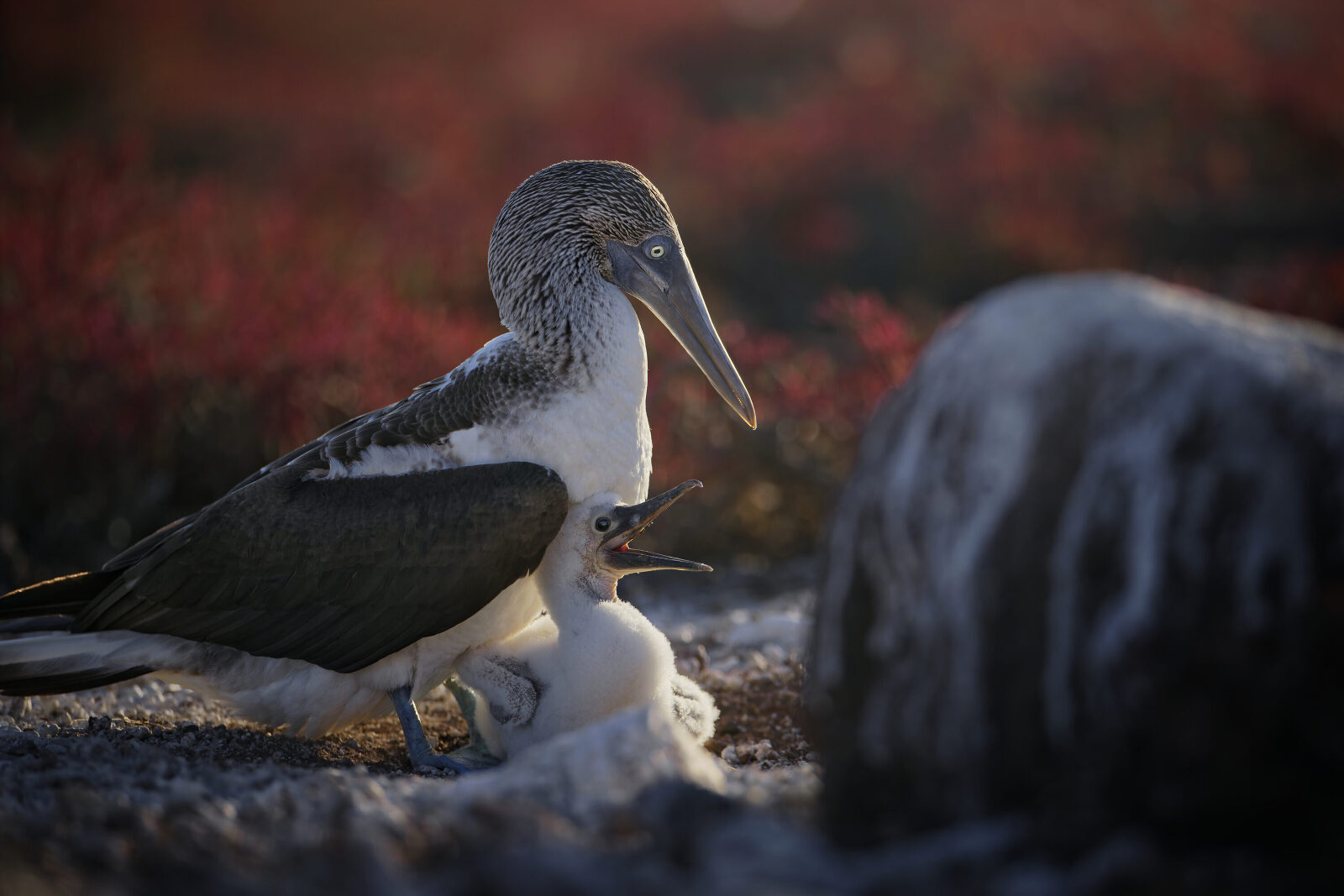


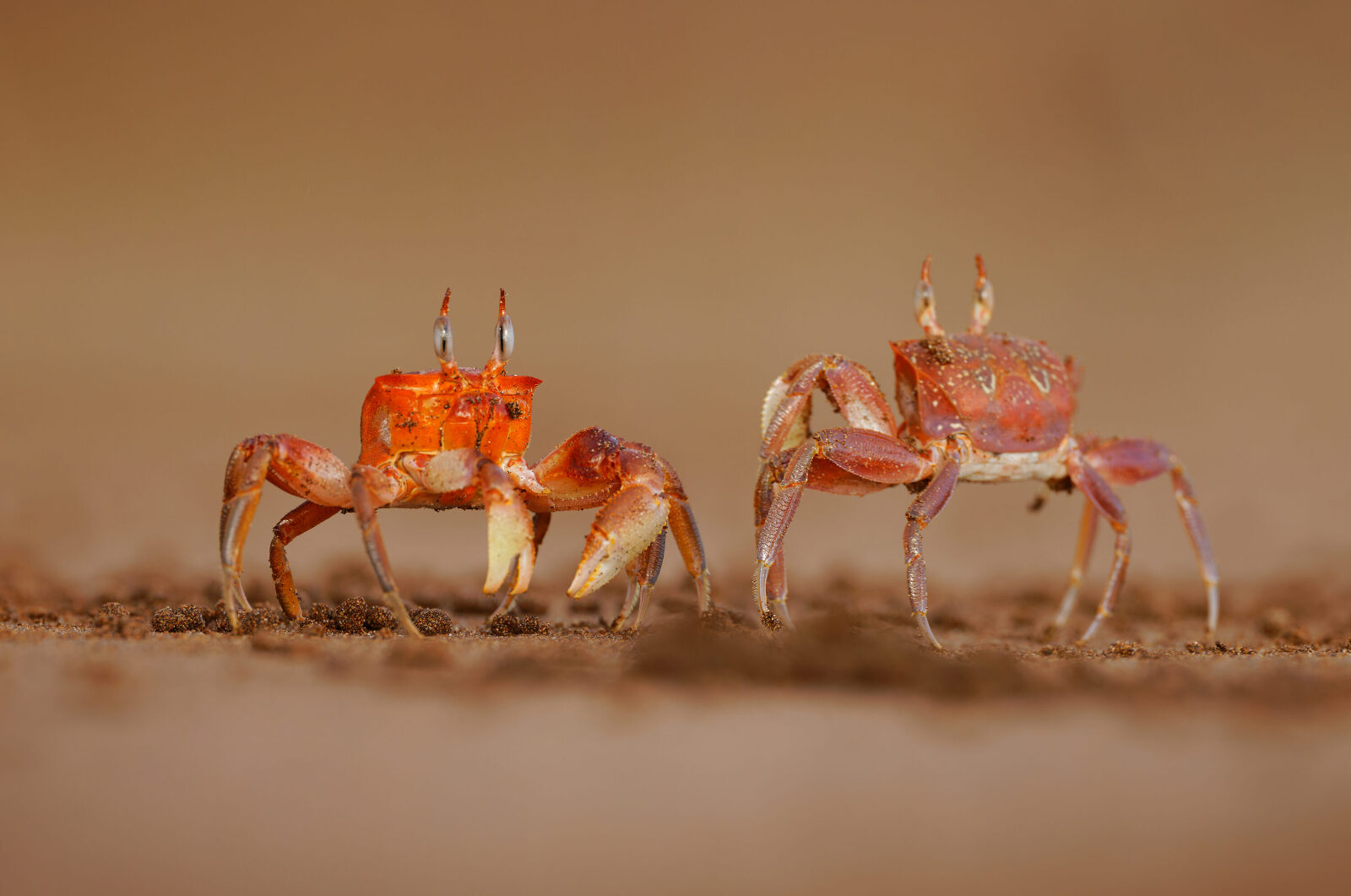



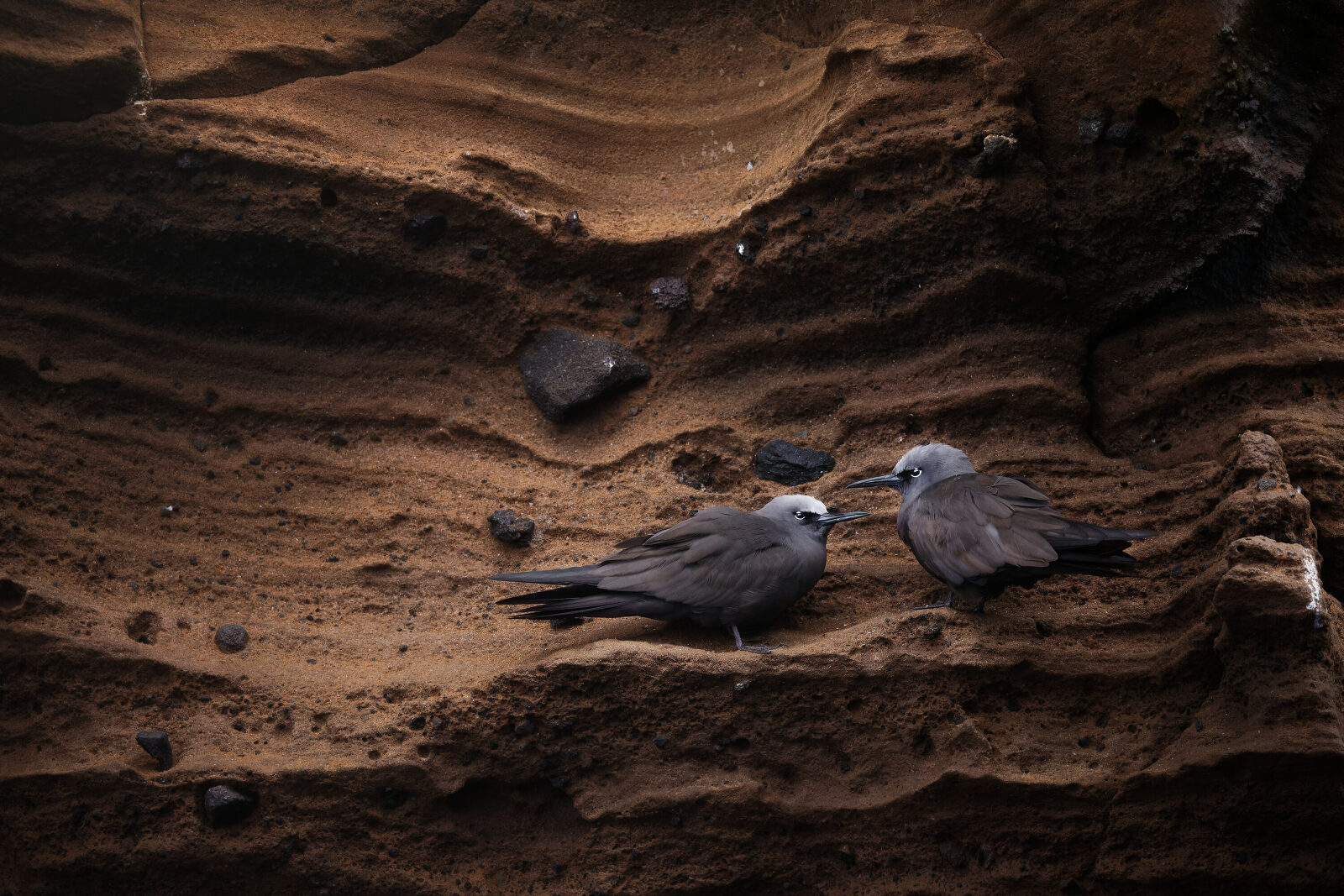
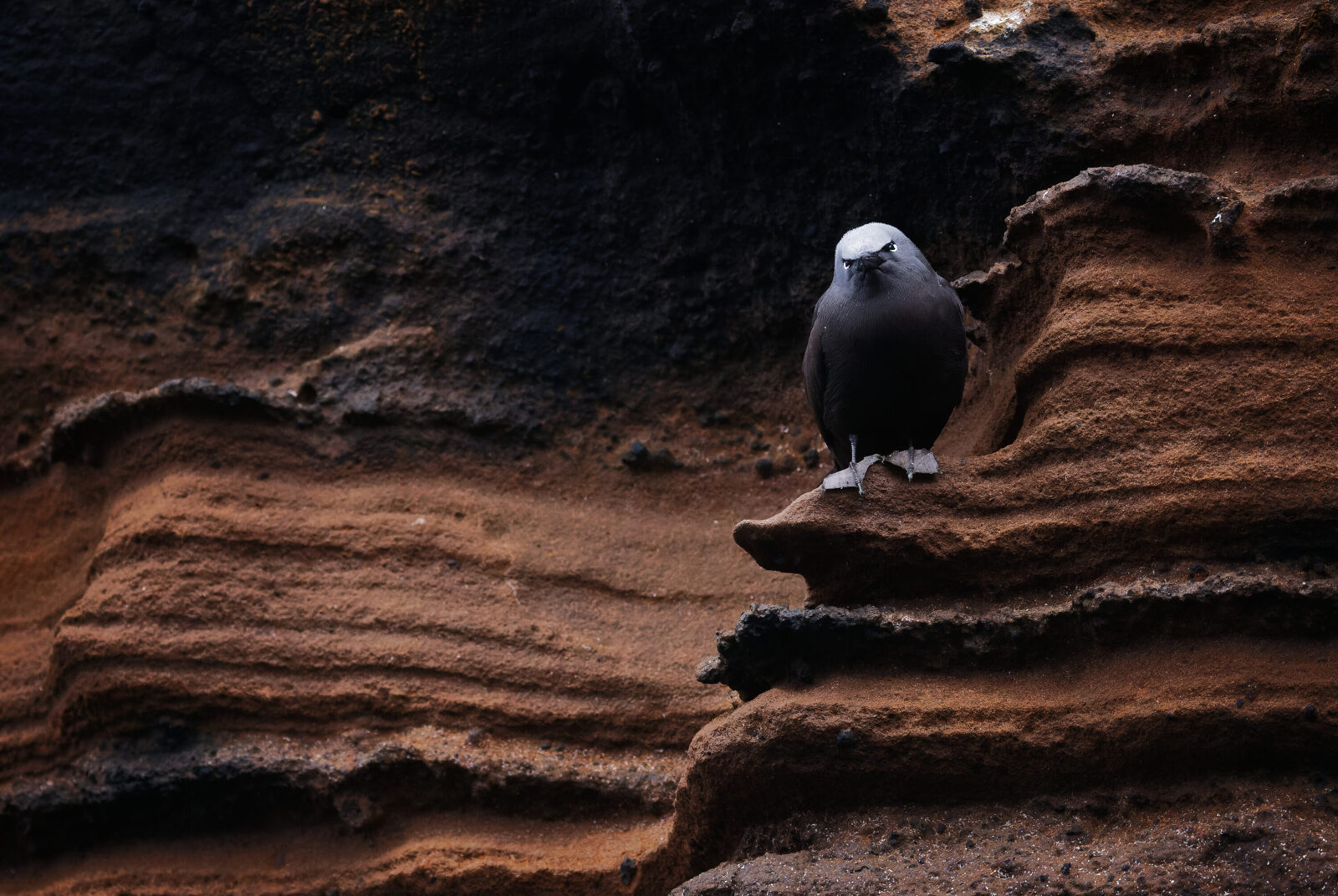






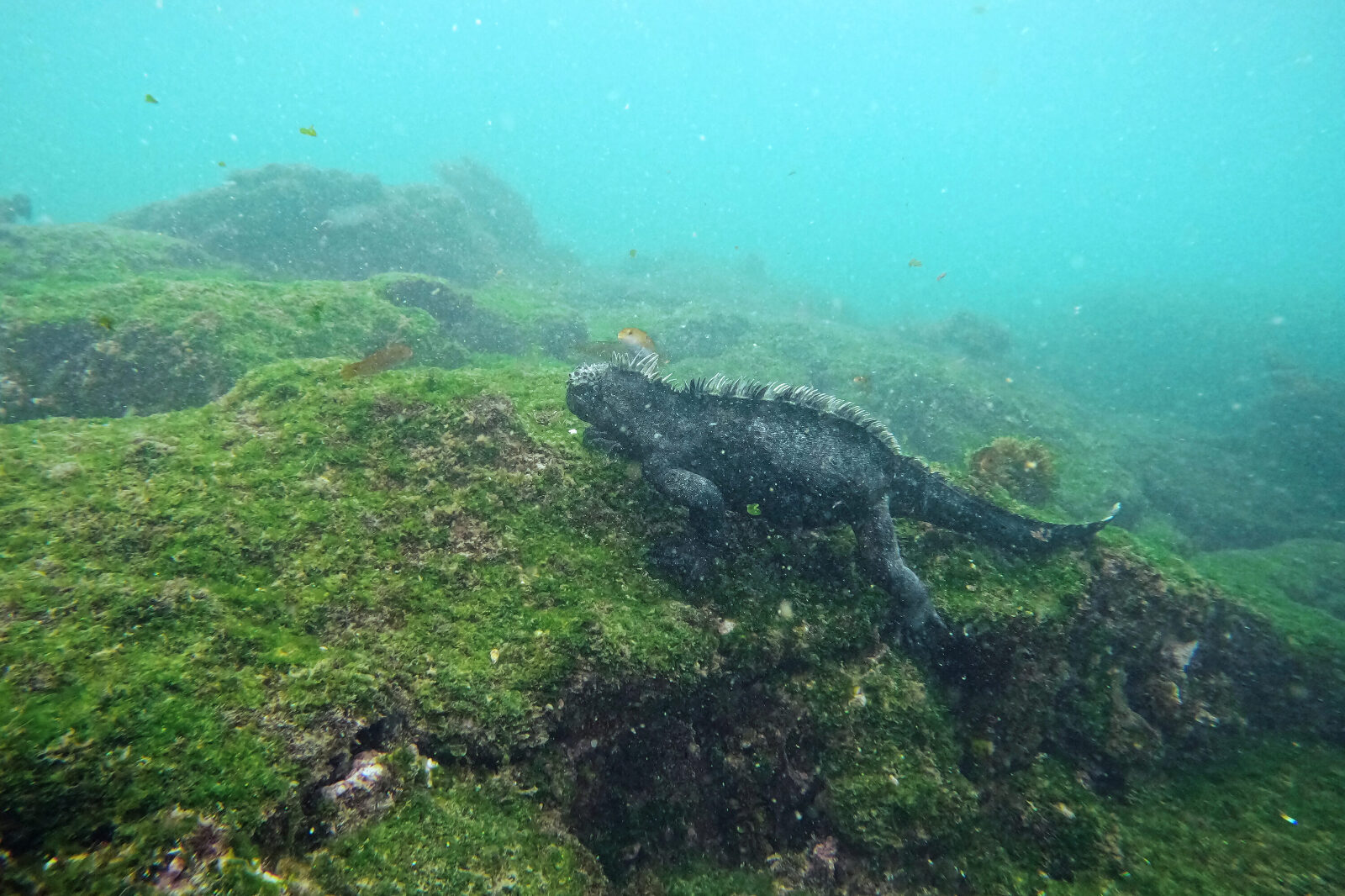

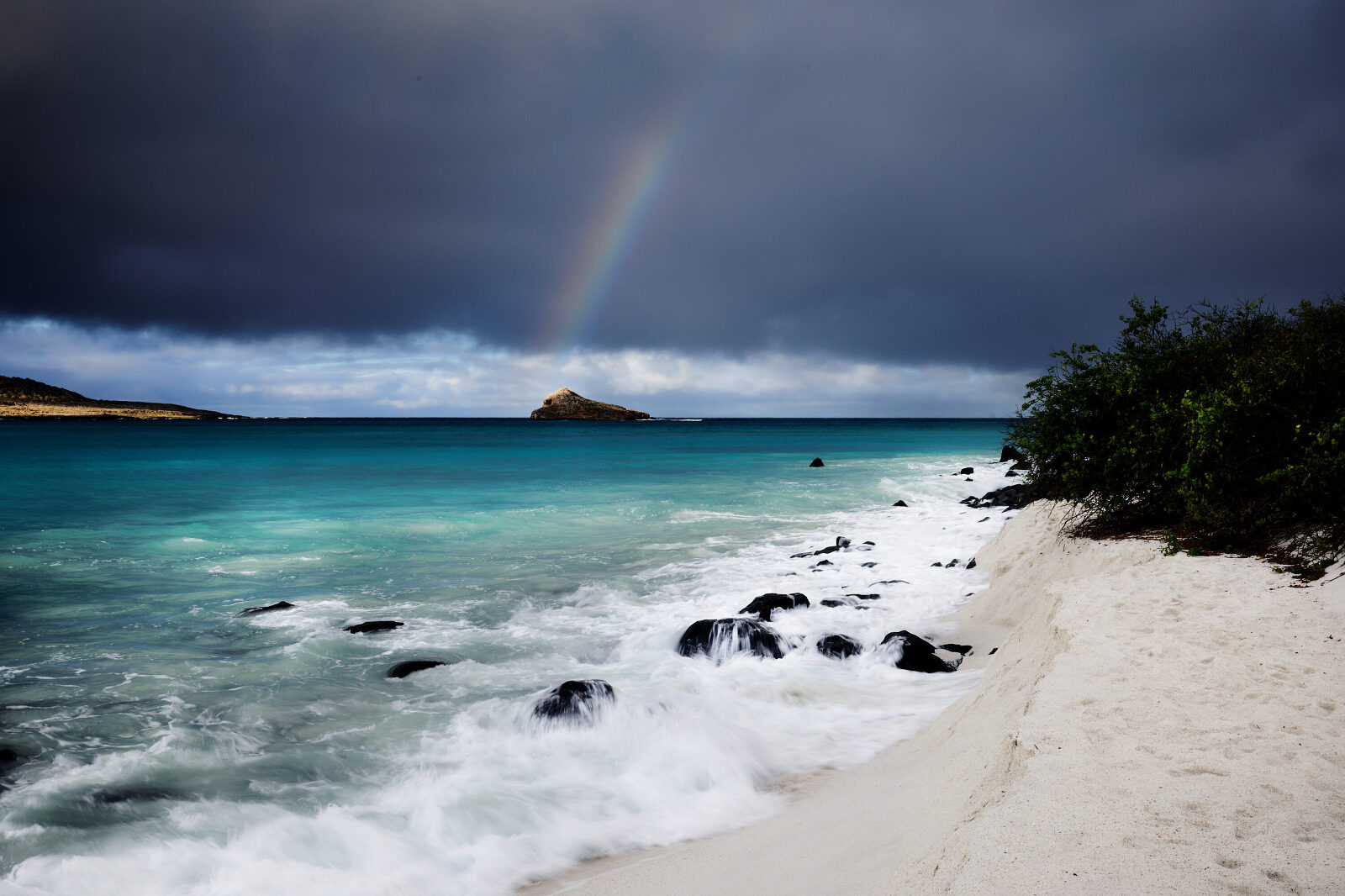

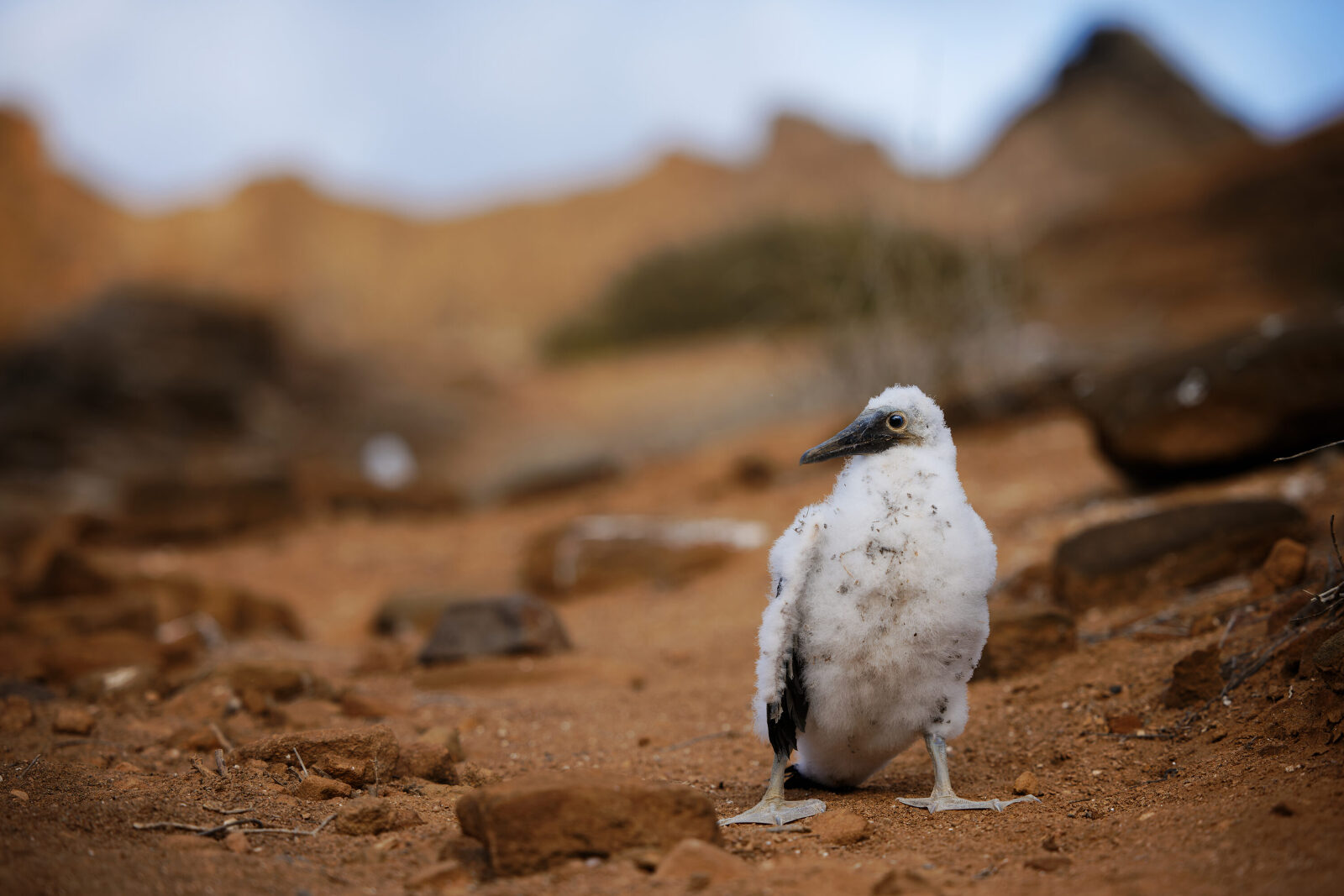
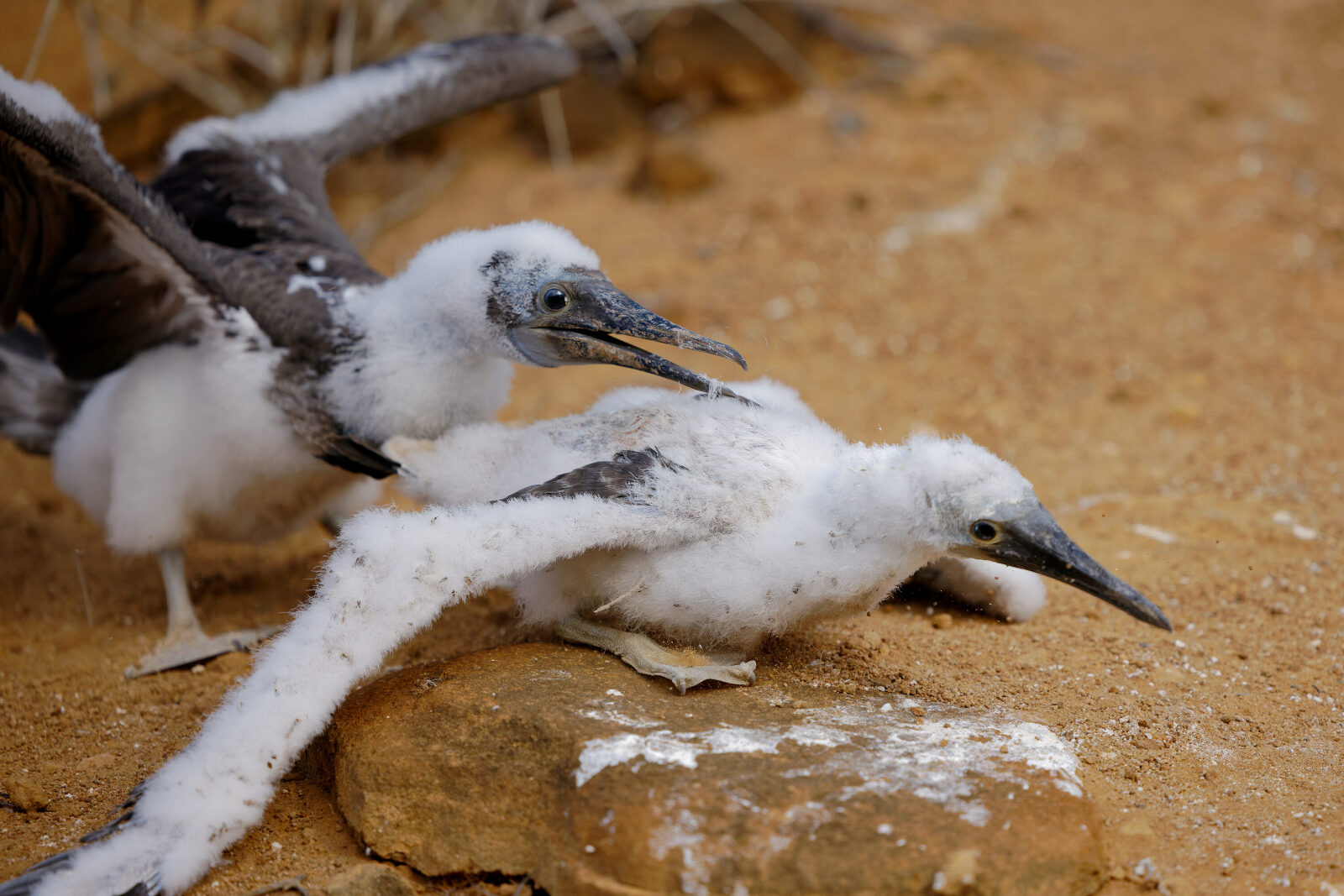


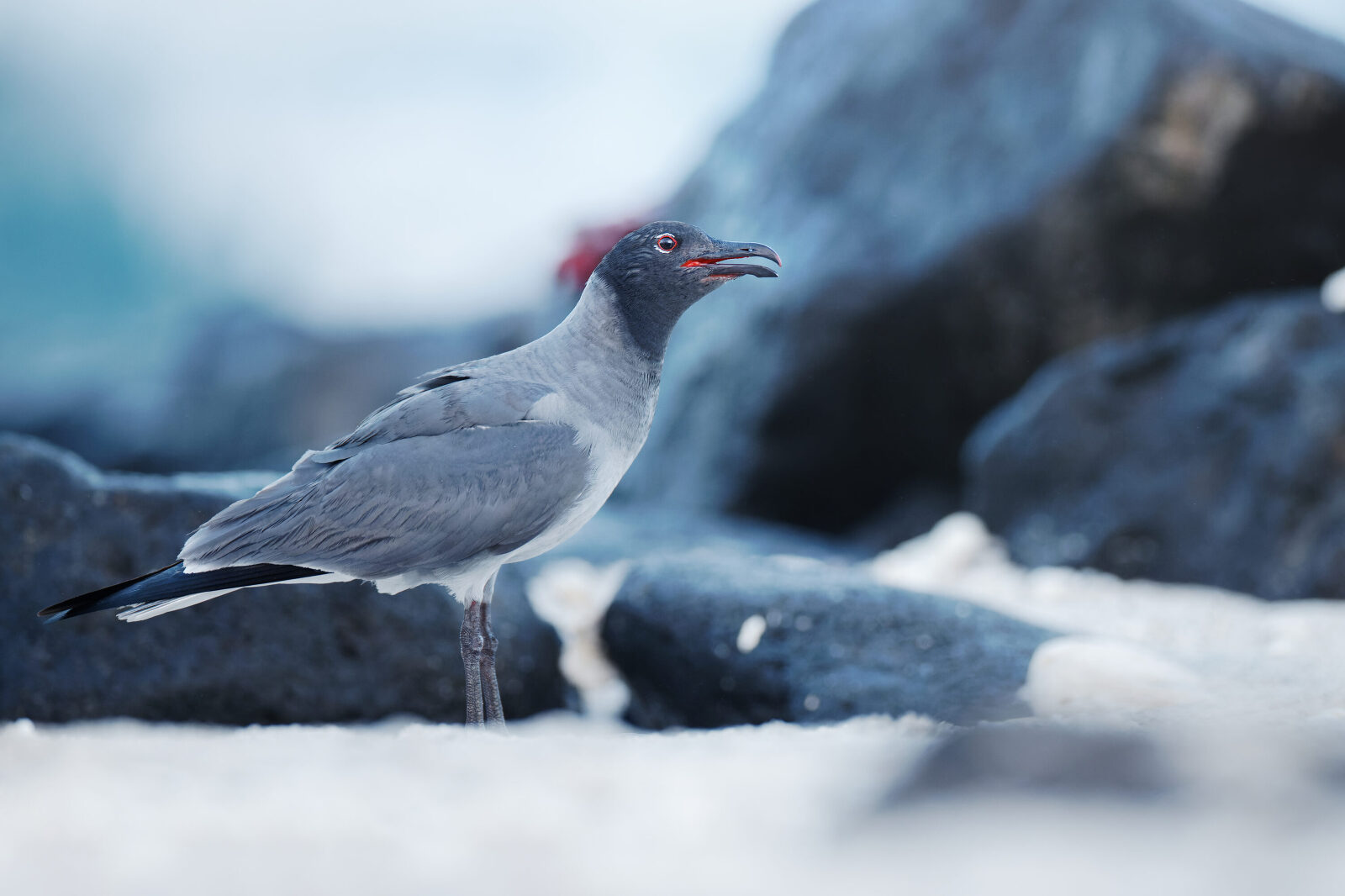
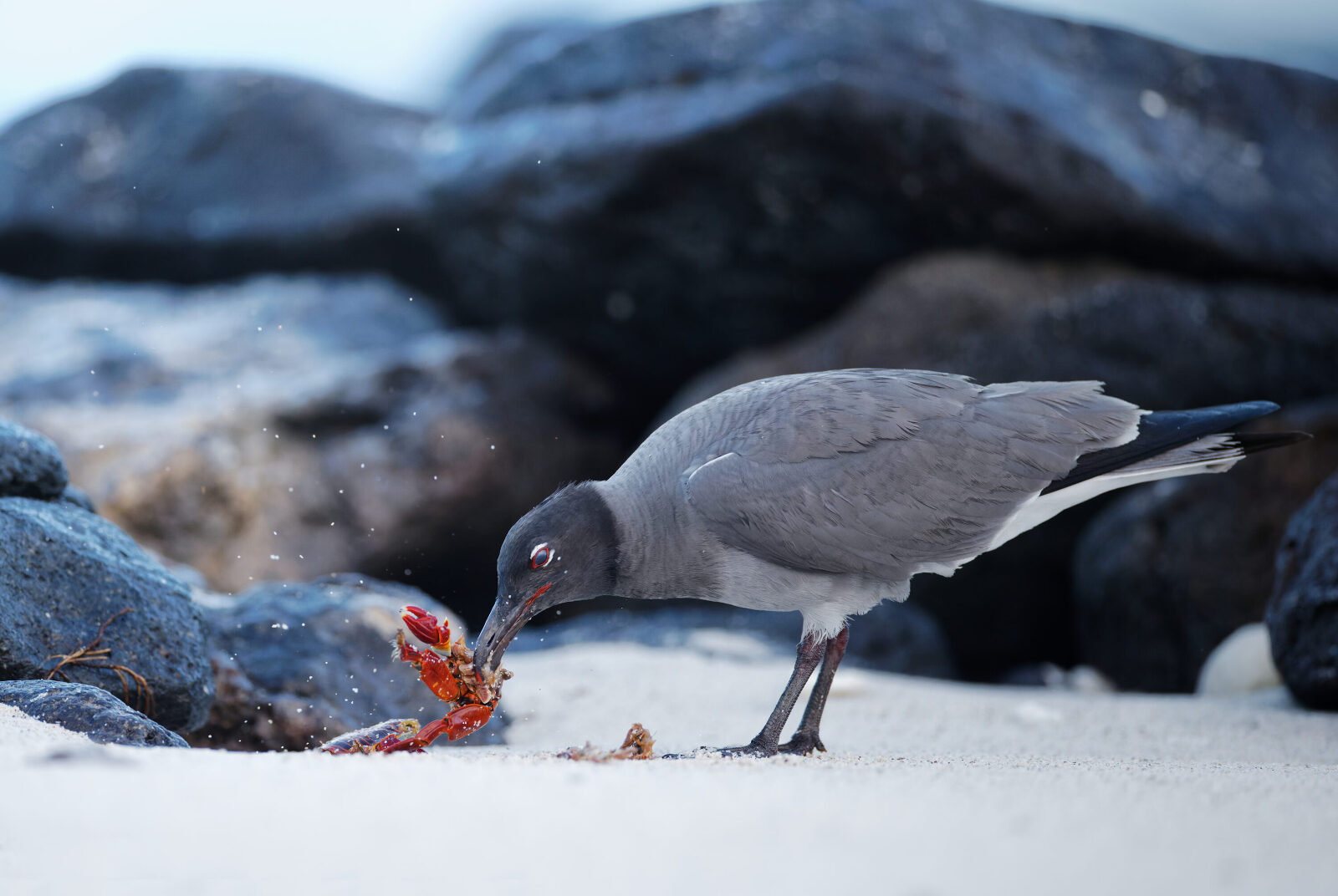

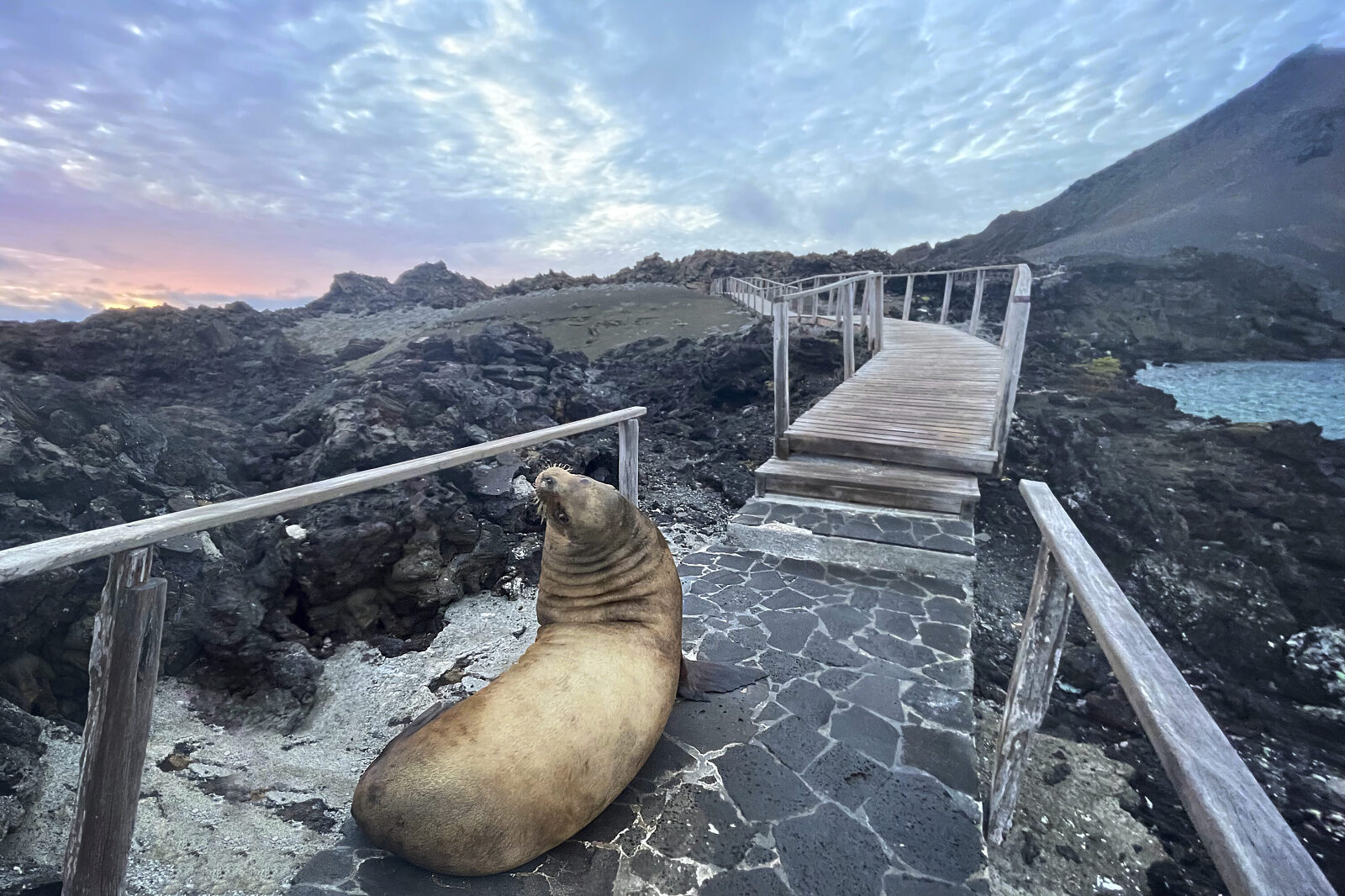

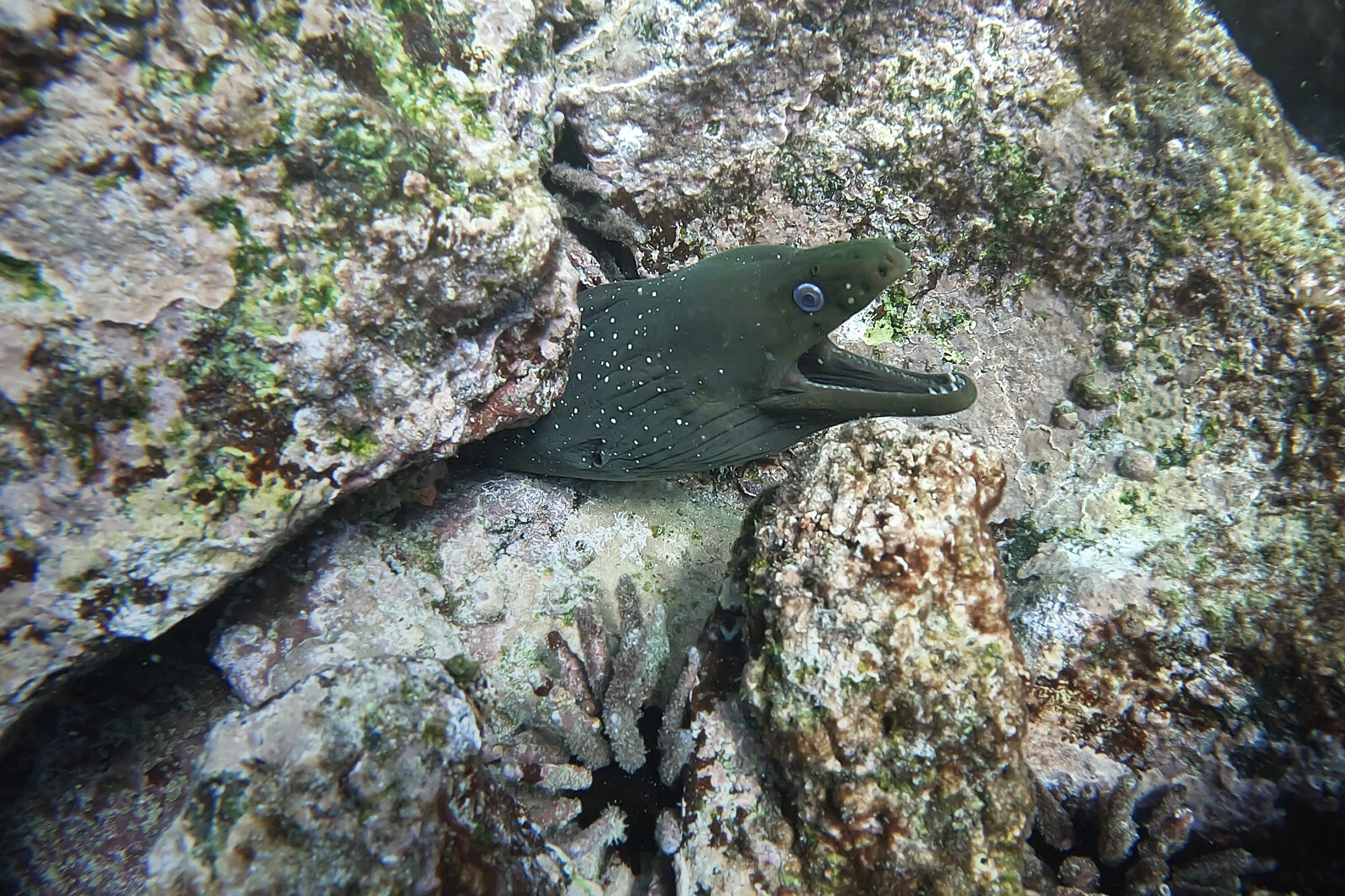
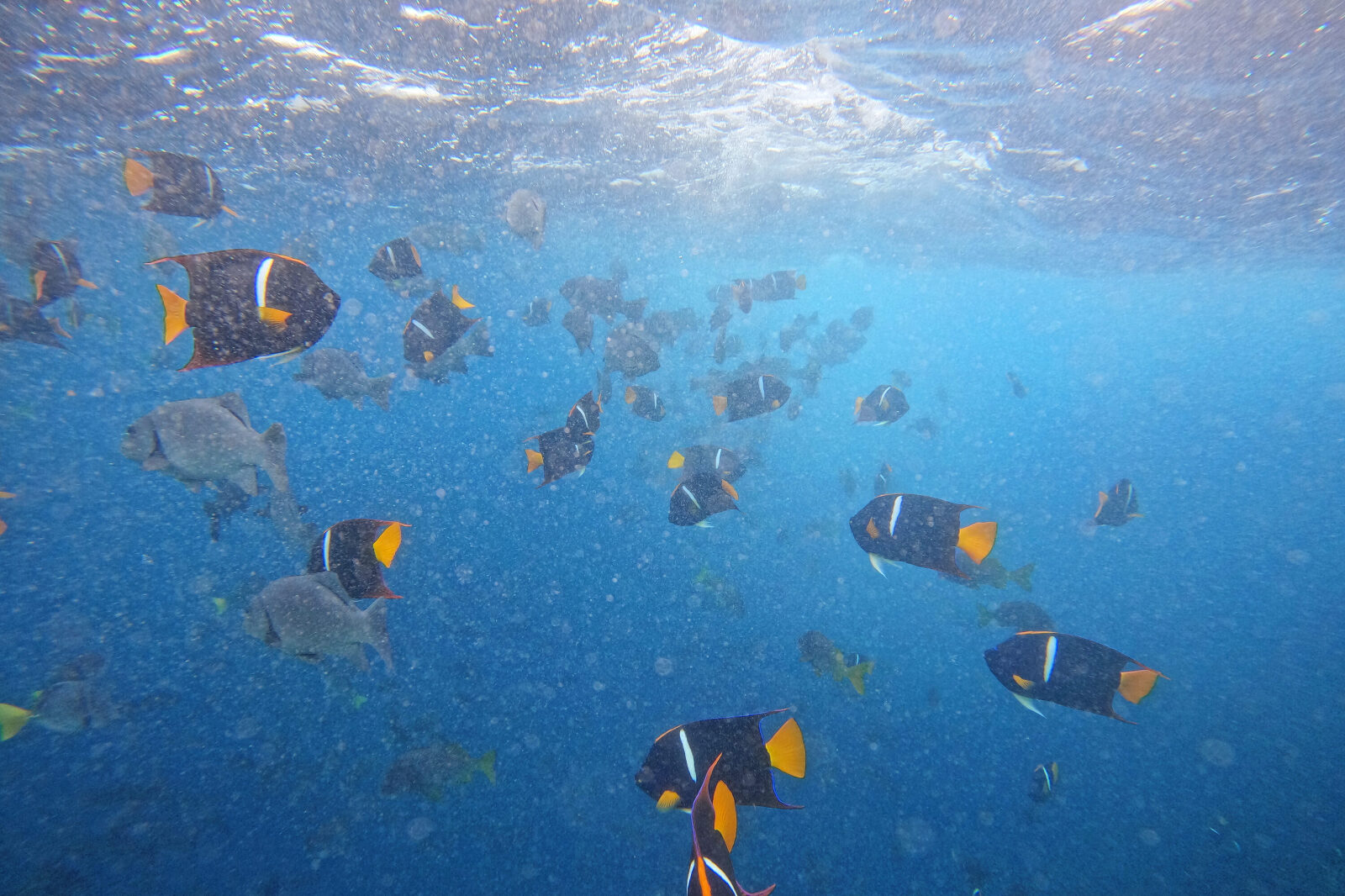
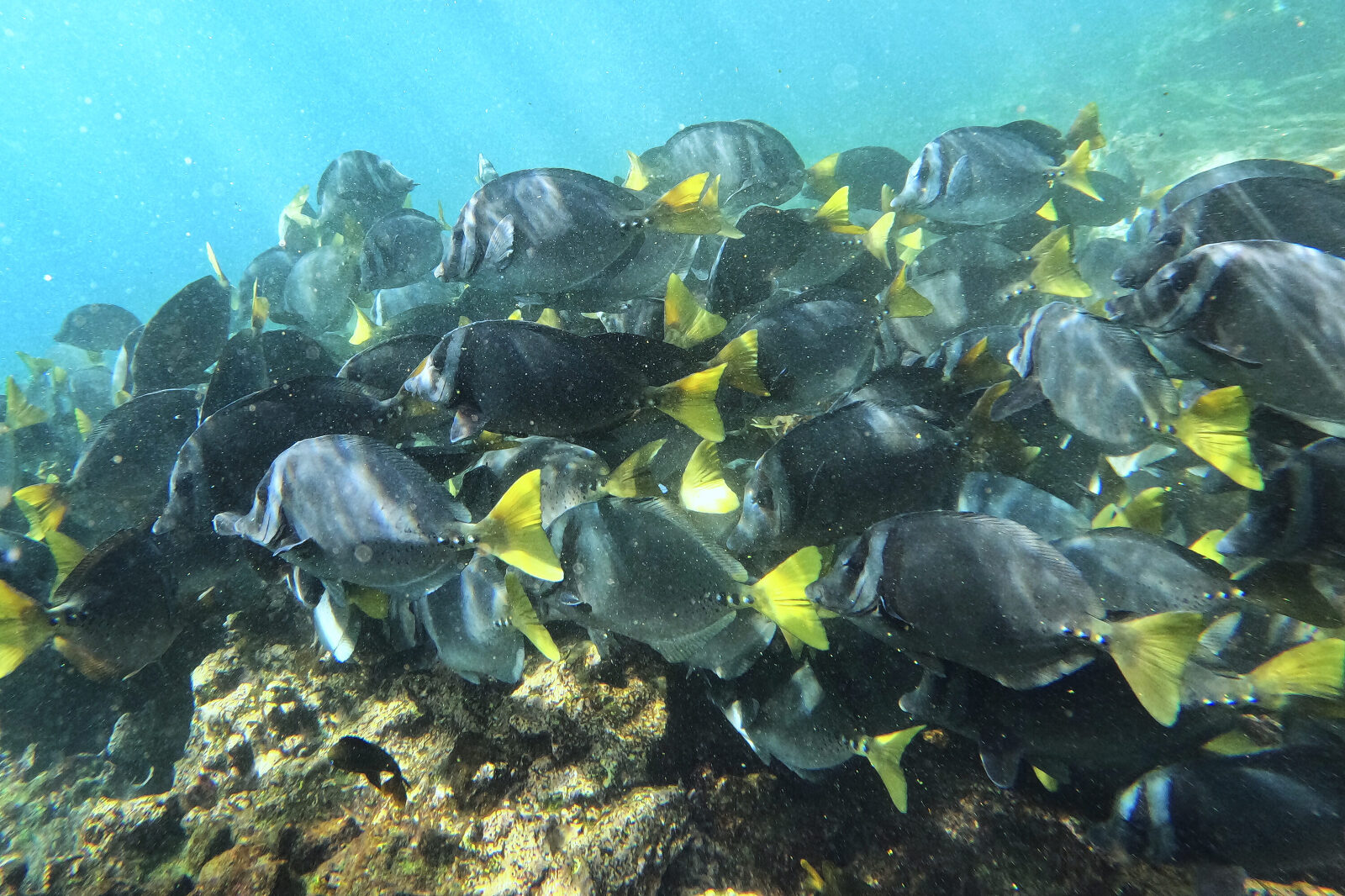

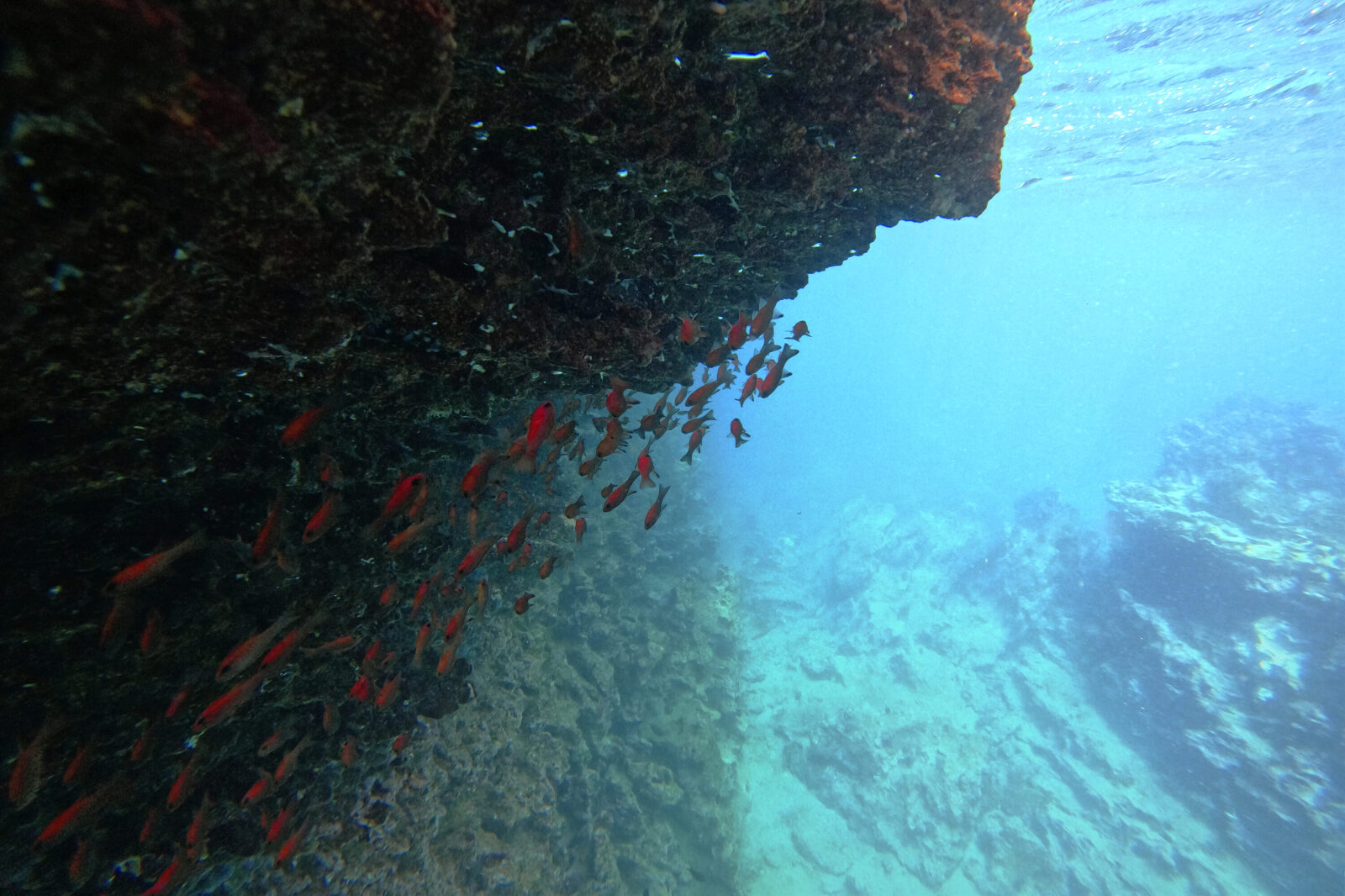

[…] we would be on a plane to the Galápagos Islands. But on our one free day in the high Andes, I intended to fill our daylight hours with as many […]
[…] from more potent introduced species on the mainland), it has some notable similarities to some other excellent places. It has large areas of protected wilderness, and a lot of hiking. And Australia […]